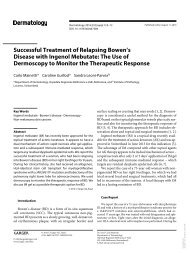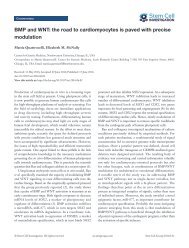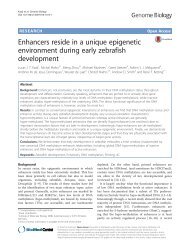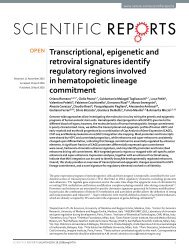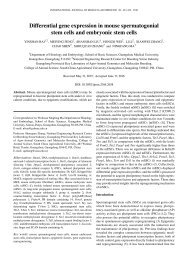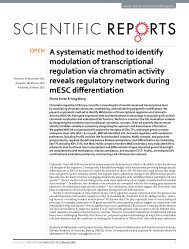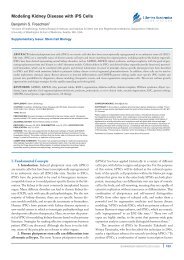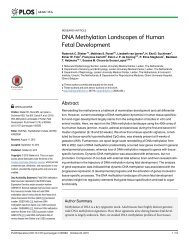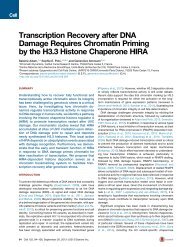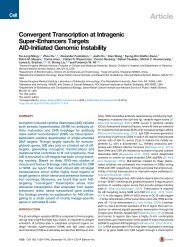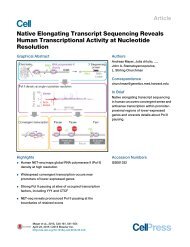12 Co-transcriptional DNA and RNA Cleavage during Type III CRISPR-Cas Immunity
You also want an ePaper? Increase the reach of your titles
YUMPU automatically turns print PDFs into web optimized ePapers that Google loves.
Article<br />
<strong>Co</strong>-<strong>transcriptional</strong> <strong>DNA</strong> <strong>and</strong> <strong>RNA</strong> <strong>Cleavage</strong> <strong>during</strong><br />
<strong>Type</strong> <strong>III</strong> <strong>CRISPR</strong>-<strong>Cas</strong> <strong>Immunity</strong><br />
Graphical Abstract<br />
Authors<br />
Poulami Samai, Nora Pyenson, ...,<br />
Asma Hatoum-Aslan,<br />
Luciano A. Marraffini<br />
<strong>Co</strong>rrespondence<br />
marraffini@rockefeller.edu<br />
In Brief<br />
The type <strong>III</strong>-A <strong>CRISPR</strong>-<strong>Cas</strong> system is<br />
capable of <strong>RNA</strong>-guided <strong>DNA</strong> <strong>and</strong> <strong>RNA</strong><br />
cleavage in vivo, revealing a highly<br />
versatile mechanism of <strong>CRISPR</strong> immunity<br />
that protects microorganisms against<br />
diverse <strong>DNA</strong> <strong>and</strong> <strong>RNA</strong> invaders.<br />
Highlights<br />
d<br />
<strong>Type</strong> <strong>III</strong> <strong>CRISPR</strong>-<strong>Cas</strong> systems provide immunity when the<br />
target <strong>DNA</strong> is transcribed<br />
d<br />
d<br />
d<br />
The type <strong>III</strong> <strong>Cas</strong>10-Csm complex performs co-<strong>transcriptional</strong><br />
<strong>RNA</strong>-guided <strong>DNA</strong> cleavage<br />
The complex is also capable of <strong>RNA</strong>-guided <strong>RNA</strong> cleavage<br />
Both the target <strong>DNA</strong> <strong>and</strong> its transcript are subject to <strong>RNA</strong>guided<br />
cleavage in vivo<br />
Samai et al., 2015, Cell 161, 1164–1174<br />
May 21, 2015 ª2015 Elsevier Inc.<br />
http://dx.doi.org/10.1016/j.cell.2015.04.027
Article<br />
<strong>Co</strong>-<strong>transcriptional</strong> <strong>DNA</strong> <strong>and</strong> <strong>RNA</strong> <strong>Cleavage</strong><br />
<strong>during</strong> <strong>Type</strong> <strong>III</strong> <strong>CRISPR</strong>-<strong>Cas</strong> <strong>Immunity</strong><br />
Poulami Samai, 1 Nora Pyenson, 1 Wenyan Jiang, 1 Gregory W. Goldberg, 1 Asma Hatoum-Aslan, 1,2<br />
<strong>and</strong> Luciano A. Marraffini 1, *<br />
1<br />
Laboratory of Bacteriology, The Rockefeller University, <strong>12</strong>30 York Avenue, New York, NY 10065, USA<br />
2<br />
Present address: Department of Biological Sciences, The University of Alabama, 300 Hackberry Lane, Tuscaloosa, AL 35487, USA<br />
*<strong>Co</strong>rrespondence: marraffini@rockefeller.edu<br />
http://dx.doi.org/10.1016/j.cell.2015.04.027<br />
SUMMARY<br />
Immune systems must recognize <strong>and</strong> destroy<br />
different pathogens that threaten the host. <strong>CRISPR</strong>-<br />
<strong>Cas</strong> immune systems protect prokaryotes from viral<br />
<strong>and</strong> plasmid infection utilizing small <strong>CRISPR</strong> <strong>RNA</strong>s<br />
that are complementary to the invader’s genome<br />
<strong>and</strong> specify the targets of <strong>RNA</strong>-guided <strong>Cas</strong> nucleases.<br />
<strong>Type</strong> <strong>III</strong> <strong>CRISPR</strong>-<strong>Cas</strong> immunity requires target<br />
transcription, <strong>and</strong> whereas genetic studies demonstrated<br />
<strong>DNA</strong> targeting, in vitro data have shown<br />
cr<strong>RNA</strong>-guided <strong>RNA</strong> cleavage. The molecular mechanism<br />
behind these disparate activities is not known.<br />
Here, we show that transcription across the targets<br />
of the Staphylococcus epidermidis type <strong>III</strong>-A<br />
<strong>CRISPR</strong>-<strong>Cas</strong> system results in the cleavage of the<br />
target <strong>DNA</strong> <strong>and</strong> its transcripts, mediated by independent<br />
active sites within the <strong>Cas</strong>10-Csm ribonucleoprotein<br />
effector complex. <strong>Immunity</strong> against plasmids<br />
<strong>and</strong> <strong>DNA</strong> viruses requires <strong>DNA</strong>, but not <strong>RNA</strong>,<br />
cleavage activity. Our studies reveal a highly versatile<br />
mechanism of <strong>CRISPR</strong> immunity that can defend<br />
microorganisms against diverse <strong>DNA</strong> <strong>and</strong> <strong>RNA</strong><br />
invaders.<br />
INTRODUCTION<br />
<strong>CRISPR</strong> (clustered regularly interspaced short palindromic<br />
repeats) loci <strong>and</strong> their associated (cas) genes encode a prokaryotic<br />
adaptive immune system that provides protection against<br />
foreign nucleic acids such as viruses (Barrangou et al., 2007)<br />
<strong>and</strong> plasmids (Marraffini <strong>and</strong> Sontheimer, 2008). In this pathway,<br />
resistance is specified by sequences derived from past invaders<br />
that lie within the <strong>CRISPR</strong> loci interspersed between repeat elements,<br />
called spacers (Bolotin et al., 2005; Mojica et al., 2005;<br />
Pourcel et al., 2005). Repeats <strong>and</strong> spacers are transcribed into<br />
a long precursor cr<strong>RNA</strong> (pre-cr<strong>RNA</strong>). This precursor is processed<br />
into small interfering <strong>CRISPR</strong> <strong>RNA</strong>s (cr<strong>RNA</strong>s) that<br />
together with <strong>Cas</strong> proteins assemble into a ribonucleoprotein<br />
(RNP) complex that uses the cr<strong>RNA</strong> as a guide to locate <strong>and</strong><br />
degrade the target nucleic acid (Brouns et al., 2008; van der<br />
Oost et al., 2014). Based on cas gene content, <strong>CRISPR</strong>-<strong>Cas</strong> systems<br />
have been categorized into three major types (I–<strong>III</strong>) (Makarova<br />
et al., 2011b). In type <strong>III</strong> systems, pre-cr<strong>RNA</strong> processing<br />
is carried out by <strong>Cas</strong>6, a repeat-specific endoribonuclease<br />
(Carte et al., 2008; Hatoum-Aslan et al., 2014). <strong>Cas</strong>6 cleavage<br />
at repeat sequences generates cr<strong>RNA</strong>s containing a full spacer<br />
sequence flanked by an 8-nt repeat sequence at the 5 0 end<br />
(the cr<strong>RNA</strong> ‘‘tag’’) <strong>and</strong> the rest of the repeat at the 3 0 (Carte<br />
et al., 2008; Marraffini <strong>and</strong> Sontheimer, 2008). A yet-uncharacterized<br />
nuclease is involved in further trimming of the 3 0 end<br />
repeat sequence to produce a heterogeneous population of<br />
mature cr<strong>RNA</strong> species that differ by 6 nt in length (Hatoum-Aslan<br />
et al., 2011, 2013).<br />
<strong>Type</strong> <strong>III</strong> <strong>CRISPR</strong>-<strong>Cas</strong> systems are further classified into <strong>III</strong>-A<br />
<strong>and</strong> <strong>III</strong>-B subtypes. Both systems harbor the type <strong>III</strong>-defining<br />
cas10 gene, but they are distinguished by the content of accessory<br />
genes: csm for <strong>III</strong>-A systems <strong>and</strong> cmr for type <strong>III</strong>-B (Makarova<br />
et al., 2011b). The cr<strong>RNA</strong>-guided targeting of nucleic acids<br />
by type <strong>III</strong>-A <strong>CRISPR</strong>-<strong>Cas</strong> systems is highly sophisticated.<br />
In vivo, targeting requires the lack of homology between the<br />
cr<strong>RNA</strong> tag <strong>and</strong> the target 5 0 flanking sequence (Marraffini <strong>and</strong><br />
Sontheimer, 2010). This requirement is thought to distinguish<br />
between bona fide targets on invading nucleic acids from the<br />
<strong>CRISPR</strong> array itself, where the presence of repeat sequences<br />
will lead to full homology with the cr<strong>RNA</strong> tag <strong>and</strong> prevent autoimmunity.<br />
In addition, transcription across the target is required<br />
for targeting in vivo (Goldberg et al., 2014). The nature of the<br />
target nucleic acid has been controversial. In vivo genetic<br />
assays demonstrated <strong>DNA</strong> targeting for the type <strong>III</strong>-A system<br />
of Staphylococcus epidermidis (Goldberg et al., 2014; Hatoum-<br />
Aslan et al., 2014; Marraffini <strong>and</strong> Sontheimer, 2008) but <strong>RNA</strong><br />
targeting for the Streptococcus thermophilus system (Tamulaitis<br />
et al., 2014). Recently, cr<strong>RNA</strong>-guided <strong>RNA</strong> targeting has been<br />
shown in vitro (Staals et al., 2014; Tamulaitis et al., 2014);<br />
however, direct demonstration of <strong>DNA</strong> cleavage has not been<br />
provided yet.<br />
Here, we performed in vivo <strong>and</strong> in vitro experiments with the<br />
type <strong>III</strong>-A <strong>CRISPR</strong>-<strong>Cas</strong> system of S. epidermidis, which demonstrate<br />
dual cr<strong>RNA</strong>-guided cleavage of the target <strong>DNA</strong> <strong>and</strong> its<br />
transcripts. We show that purified <strong>Cas</strong>10-Csm complexes<br />
cleave double-str<strong>and</strong>ed <strong>DNA</strong> targets. The reaction absolutely requires<br />
transcription across the target, <strong>and</strong> it is inhibited by the<br />
presence of homology between the cr<strong>RNA</strong> tag <strong>and</strong> the 5 0 target<br />
flanking sequence. The same complex is also capable of cr<strong>RNA</strong>guided<br />
<strong>RNA</strong> cleavage in vitro, <strong>and</strong> this reaction is not prevented<br />
by cr<strong>RNA</strong> tag homology. In vivo, type <strong>III</strong>-A targeting of a plasmid<br />
shows degradation of the <strong>DNA</strong> upon induction of transcription<br />
1164 Cell 161, 1164–1174, May 21, 2015 ª2015 Elsevier Inc.
polymerase domain, <strong>RNA</strong> targeting requires a nucleolytic active<br />
site in Csm3, both in vitro <strong>and</strong> in vivo. Mutations that affect <strong>DNA</strong><br />
cleavage do not affect <strong>RNA</strong> cleavage <strong>and</strong> vice versa. Finally,<br />
in vivo experiments show that <strong>DNA</strong>, but not <strong>RNA</strong>, cleavage is<br />
required for immunity against plasmids <strong>and</strong> <strong>DNA</strong> viruses. These<br />
results consolidate all the different mechanistic observations of<br />
type <strong>III</strong>-A targeting into a single model <strong>and</strong> uncover a highly elaborate<br />
targeting strategy distinct from the type I <strong>and</strong> type II<br />
<strong>CRISPR</strong>-<strong>Cas</strong> systems studied so far (Barrangou <strong>and</strong> Marraffini,<br />
2014).<br />
RESULTS<br />
Figure 1. cr<strong>RNA</strong>-Guided <strong>Co</strong>-<strong>transcriptional</strong> <strong>DNA</strong> <strong>Cleavage</strong> by the<br />
S. epidermidis <strong>Cas</strong>10-Csm <strong>Co</strong>mplex<br />
(A) S. epidermidis RP62a carries a <strong>CRISPR</strong>-<strong>Cas</strong> locus that harbors four repeats<br />
(black boxes), three spacers (colored boxes), <strong>and</strong> nine cas/csm genes, five of<br />
which (highlighted in blue) encode for the <strong>Cas</strong>10-Csm ribonucleoprotein<br />
complex.<br />
(B) The first spacer sequence (spc1) generates a mature cr<strong>RNA</strong> that targets a<br />
complementary sequence in the nickase gene (nes) present in most staphylococcal<br />
conjugative plasmids (green). The most abundant mature cr<strong>RNA</strong><br />
species contains 33 nt of spacer sequence as well as 8 nt of repeat sequences<br />
at its 5 0 end, known as the cr<strong>RNA</strong> tag (light green).<br />
(C) SDS-PAGE of the <strong>Cas</strong>10-Csm complex purified from E. coli.<br />
(D) Schematic of the co-<strong>transcriptional</strong> <strong>DNA</strong> cleavage assay of a ds<strong>DNA</strong><br />
substrate containing the nes target. Arrowheads indicate the approximate<br />
cleavage site detected in (E).<br />
(E <strong>and</strong> F) Denaturing PAGE <strong>and</strong> autoradiography of the products of two co<strong>transcriptional</strong><br />
ds<strong>DNA</strong> cleavage assays differing in the location of the radioactive<br />
label: (E) non-template str<strong>and</strong>; (F) template str<strong>and</strong>. <strong>Cleavage</strong> products<br />
were collected at 30, 60, 90, <strong>and</strong> <strong>12</strong>0 min. Reactions in which each of the<br />
components of the assay were omitted in a <strong>12</strong>0-min assay are shown as<br />
controls.<br />
across the target, as well as a precise cut of the target transcript.<br />
We also show that <strong>DNA</strong> <strong>and</strong> <strong>RNA</strong> targeting are independent<br />
events. Whereas <strong>DNA</strong> targeting requires an intact <strong>Cas</strong>10 palm<br />
cr<strong>RNA</strong>-Guided <strong>DNA</strong> <strong>Cleavage</strong> by the <strong>Cas</strong>10-Csm<br />
<strong>Co</strong>mplex Requires Target Transcription<br />
Whereas genetic evidence demonstrated <strong>DNA</strong> targeting for the<br />
S. epidermidis type <strong>III</strong>-A <strong>CRISPR</strong>-<strong>Cas</strong> system (Goldberg et al.,<br />
2014; Hatoum-Aslan et al., 2014; Marraffini <strong>and</strong> Sontheimer,<br />
2008), direct evidence of <strong>DNA</strong> cleavage has been elusive. We<br />
previously showed that the S. epidermidis <strong>CRISPR</strong>-<strong>Cas</strong> locus<br />
(Figure 1A) encodes for a ribonucleoprotein complex composed<br />
of <strong>Cas</strong>10, Csm2, Csm3, Csm4, Csm5, <strong>and</strong> the cr<strong>RNA</strong> guide,<br />
known as the <strong>Cas</strong>10-Csm complex (Hatoum-Aslan et al., 2013,<br />
2014). One of the cr<strong>RNA</strong>s (encoded by the first spacer, spc1)<br />
matches a region of the nickase gene present in most staphylococcal<br />
conjugative plasmids (Marraffini <strong>and</strong> Sontheimer, 2008);<br />
this region was selected as the target for our in vivo <strong>and</strong><br />
in vitro studies (Figure 1B). We expressed these proteins in<br />
Escherichia coli to purify the complex to homogeneity (Figure<br />
1C). The complex was co-expressed with the repeat-spacer<br />
array, <strong>and</strong> therefore it is loaded with the mature cr<strong>RNA</strong> species<br />
that differ by increments of 6 nt (Figure S1A). As observed for<br />
other type <strong>III</strong>-A <strong>CRISPR</strong>-<strong>Cas</strong> systems (Staals et al., 2014; Tamulaitis<br />
et al., 2014), the <strong>Cas</strong>10-Csm complex was incapable of<br />
cleaving a complementary single-str<strong>and</strong>ed <strong>DNA</strong> (ss<strong>DNA</strong>) or<br />
double-str<strong>and</strong>ed <strong>DNA</strong> (ds<strong>DNA</strong>) oligonucleotide substrates in<br />
different assay conditions (Figures S1B <strong>and</strong> S1C). Recently, we<br />
reported that transcription of the target sequence is required<br />
for type <strong>III</strong>-A <strong>CRISPR</strong> immunity (Goldberg et al., 2014). In order<br />
to test whether target transcription facilitates <strong>DNA</strong> cleavage,<br />
we used an oligonucleotide-based <strong>RNA</strong>P transcription system,<br />
where stepwise assembly of purified <strong>RNA</strong> <strong>and</strong> <strong>DNA</strong> oligonucleotides<br />
<strong>and</strong> E. coli core <strong>RNA</strong> polymerase can reconstitute fully<br />
functional <strong>RNA</strong>P elongation complexes (Sidorenkov et al.,<br />
1998). In this assay, each oligonucleotide (the <strong>RNA</strong> primer, the<br />
template str<strong>and</strong> or the non-template str<strong>and</strong>) can be radioactively<br />
labeled prior to assembly to follow their fate in the reaction. The<br />
<strong>DNA</strong> oligonucleotides were complementary to each other <strong>and</strong><br />
contained the nes target (35 nt complementary to the spc1<br />
cr<strong>RNA</strong>) <strong>and</strong> its flanking sequences (24 nt on each side). The elongation<br />
complex is assembled in the presence of transcription<br />
buffer containing Mg 2+ by the annealing of an <strong>RNA</strong> primer to<br />
the template str<strong>and</strong>, followed by the addition of <strong>RNA</strong>P <strong>and</strong> the<br />
annealing of the non-template str<strong>and</strong> (Figure 1D). Assembled<br />
elongation complexes were incubated with purified <strong>Cas</strong>10-<br />
Csm, <strong>and</strong> transcription was started by supplementing rNTPs.<br />
Extension of 5 0 -radiolabeled <strong>RNA</strong> primers confirmed transcription<br />
elongation (Figure S1D). We labeled each str<strong>and</strong> of the<br />
Cell 161, 1164–1174, May 21, 2015 ª2015 Elsevier Inc. 1165
Figure 2. <strong>RNA</strong>P Elongation Is Required for<br />
<strong>Cas</strong>10-Csm Target <strong>Cleavage</strong><br />
(A) The small molecule CBR703 inhibits <strong>RNA</strong>P<br />
elongation <strong>and</strong> was tested in our <strong>DNA</strong> cleavage<br />
assay to corroborate the transcription requirement<br />
for cleavage.<br />
(B) CBR703 inhibits transcription elongation.<br />
Using a radiolabeled <strong>RNA</strong> primer, we measured<br />
transcription elongation in different conditions in<br />
the presence (1 mM) or absence of CBR703.<br />
Extension products were collected at 30, 60, 90,<br />
<strong>and</strong> <strong>12</strong>0 min. Reactions in which each of the<br />
components of the assay was omitted in a <strong>12</strong>0-<br />
min assay are shown as controls.<br />
(C) In vitro <strong>DNA</strong> cleavage assay using a radiolabeled<br />
non-template str<strong>and</strong> (as in Figure 1E) in<br />
the presence (1 mM) or absence of CBR703. Reaction<br />
products were collected at 30, 60, 90, <strong>and</strong><br />
<strong>12</strong>0 min. Reactions in which each of the components<br />
of the assay was omitted in a <strong>12</strong>0-min assay<br />
are shown as controls.<br />
substrate in different experiments <strong>and</strong> analyzed the products of<br />
the reaction by denaturing PAGE <strong>and</strong> autoradiography. We detected<br />
cleavage of the non-template str<strong>and</strong> at two defined sites,<br />
only after the start of transcription by the addition of rNTPs<br />
(compare lanes 3 <strong>and</strong> 4–7, Figure 1E). Interestingly, an estimation<br />
of the cleavage sites based on the size of the product indicates<br />
that it occurred on the 3 0 flanking side of the target, not<br />
within the region with complementary to the cr<strong>RNA</strong> (Figure 1D).<br />
Further <strong>DNA</strong> degradation to the nucleotide level was observed<br />
with longer incubation times (Figure 1E). The template str<strong>and</strong>,<br />
in contrast, was neither cleaved nor degraded (Figure 1F). To unequivocally<br />
demonstrate a transcription requirement for <strong>DNA</strong><br />
cleavage, we used an <strong>RNA</strong>P elongation inhibitor, CBR703 (Artsimovitch<br />
et al., 2003). This small molecule inhibitor prevents<br />
nucleotide addition <strong>during</strong> transcription <strong>and</strong> therefore it should<br />
impair <strong>DNA</strong> cleavage by the <strong>Cas</strong>10-Csm complex (Figure 2A).<br />
First we corroborated that the addition of CBR703 prevents efficient<br />
transcription elongation in our assay, by radiolabeling the<br />
<strong>RNA</strong> primer (Figure 2B). When the same assay was performed<br />
using a radiolabeled non-template str<strong>and</strong>, the inhibition of transcription<br />
elongation with CBR703 prevented <strong>DNA</strong> cleavage<br />
(Figure 2C). Altogether these results reveal the molecular mechanism<br />
of type <strong>III</strong>-A <strong>DNA</strong> targeting: transcription-dependent <strong>DNA</strong><br />
cleavage of the non-template str<strong>and</strong>.<br />
Two previous genetic observations revealed an unexpected<br />
targeting mechanism for type <strong>III</strong>-A systems. First, only cr<strong>RNA</strong>s<br />
complementary to the non-template str<strong>and</strong> provide efficient<br />
immunity (Goldberg et al., 2014)(Figures S2A <strong>and</strong> S2B). Second,<br />
the prevention of autoimmunity in type <strong>III</strong>-A systems, i.e., the<br />
spc1 cr<strong>RNA</strong>-guided targeting of spc1 <strong>DNA</strong> in the <strong>CRISPR</strong> array,<br />
requires homology between the cr<strong>RNA</strong> tag <strong>and</strong> the repeat se-<br />
quences that flank the 3 0 end of the<br />
spacer <strong>DNA</strong> (of the targeted str<strong>and</strong>,<br />
complementary to the cr<strong>RNA</strong> spacer<br />
sequence) (Marraffini <strong>and</strong> Sontheimer,<br />
2010) (Figure S2C). Presumably this is<br />
achieved by the pairing between these sequences. The development<br />
of an in vitro <strong>DNA</strong> cleavage assay allowed us to test<br />
whether the lack of immunity observed in these two genetic experiments<br />
reflects an abrogation of target <strong>DNA</strong> cleavage by the<br />
<strong>Cas</strong>10-Csm complex. To test for <strong>DNA</strong> cleavage mediated by a<br />
cr<strong>RNA</strong> complementary to the template str<strong>and</strong>, we used an<br />
<strong>RNA</strong> primer that anneals to the top str<strong>and</strong> of our ds<strong>DNA</strong> substrate<br />
to assemble the elongation complex (Figure 3A). Incubation<br />
with the <strong>Cas</strong>10-Csm complex in identical conditions to those<br />
that led to cleavage of the non-template str<strong>and</strong> produced no<br />
cleavage of either str<strong>and</strong> (Figure 3B), even in the presence of<br />
target transcription (Figure S1D). To test for <strong>DNA</strong> cleavage in<br />
the anti-autoimmunity scenario, we modified the target to introduce<br />
the corresponding repeat sequences at the 3 0 flank of the<br />
spc1 cr<strong>RNA</strong> complementarity region (Figure 3C). We then<br />
assembled the elongation complex <strong>and</strong> tested for cleavage of<br />
each <strong>DNA</strong> str<strong>and</strong>. We did not detect any cleavage or degradation,<br />
regardless of target transcription (Figure 3D). This result<br />
indicates that, in addition to target transcription, <strong>DNA</strong> cleavage<br />
requires mismatches between the cr<strong>RNA</strong> tag <strong>and</strong> the 3 0 flanking<br />
region of the target, thus providing the molecular basis for the<br />
prevention of autoimmunity, a central feature of all immune<br />
systems.<br />
cr<strong>RNA</strong>-Guided <strong>RNA</strong> <strong>Cleavage</strong> by the <strong>Cas</strong>10-Csm<br />
<strong>Co</strong>mplex<br />
Recently, it has been reported that type <strong>III</strong>A in Streptococcus<br />
thermophilus <strong>and</strong> Thermus thermophilus can cleave ss<strong>RNA</strong> targets<br />
(Staals et al., 2014; Tamulaitis et al., 2014), a function that<br />
allows protection against <strong>RNA</strong> viruses (Tamulaitis et al., 2014).<br />
In both of these systems, the <strong>Cas</strong>10-Csm complex cleaves<br />
1166 Cell 161, 1164–1174, May 21, 2015 ª2015 Elsevier Inc.
Figure 3. In Vitro <strong>Cleavage</strong> Reflects In Vivo<br />
Targeting<br />
(A) Schematic of the substrate used to test for <strong>DNA</strong><br />
cleavage in conditions where the cr<strong>RNA</strong> matches<br />
the template str<strong>and</strong>.<br />
(B) In vitro <strong>DNA</strong> cleavage assay of the substrate<br />
shown in (A), with the radiolabel either in the<br />
template (left autoradiography) or non-template<br />
(right) str<strong>and</strong>. Reaction products were collected at<br />
30, 60, 90, <strong>and</strong> <strong>12</strong>0 min. Reactions in which each<br />
of the components of the assay was omitted in a<br />
<strong>12</strong>0-min assay are shown as controls.<br />
(C) Schematic of the ‘‘anti-tag’’ substrate in which<br />
the flanking sequence downstream on the nes<br />
target matches the 5 0 cr<strong>RNA</strong> tag (light green),<br />
generating a full match between the cr<strong>RNA</strong> <strong>and</strong><br />
the <strong>DNA</strong> target.<br />
(D) In vitro <strong>DNA</strong> cleavage assay of the substrate<br />
shown in (C), with the non-template str<strong>and</strong> radiolabeled.<br />
Reaction products were collected at 30,<br />
60, 90, <strong>12</strong>0, <strong>and</strong> 180 min. Reactions in which each<br />
of the components of the assay was omitted in a<br />
<strong>12</strong>0-min assay are shown as controls.<br />
<strong>RNA</strong> at multiple sites at 6-nt intervals. We also investigated the<br />
ribonuclease activity of the S. epidermidis complex. A 55-nt,<br />
5 0 -radiolabeled ss<strong>RNA</strong> substrate complementary to spc1 cr<strong>RNA</strong><br />
(Figure 4A) was incubated with the <strong>Cas</strong>10-Csm complex in a<br />
buffer containing Mg 2+ , <strong>and</strong> the reaction was subjected to<br />
denaturing gel separation <strong>and</strong> autoradiography. We observed<br />
sequence specific endoribonuclease activity against the ss<strong>RNA</strong><br />
substrate complementary to spc1 cr<strong>RNA</strong>, with multiple cleavage<br />
products showing the reported 6-nt periodicity (Figure 4C; Figures<br />
S3A <strong>and</strong> S3B). No activity was observed with a 55-nt scrambled,<br />
control <strong>RNA</strong> substrate (Figures S3C <strong>and</strong> S3D). A conserved<br />
aspartate residue in Csm3 (D32 in the S. epidermidis homolog)<br />
was identified to be the active site residue responsible for<br />
the endoribonuclease activity in the S. thermophilus <strong>and</strong><br />
T. thermophilus complexes (Staals et al., 2014; Tamulaitis<br />
et al., 2014). We made the corresponding alanine substitution,<br />
D32A, purified the <strong>Cas</strong>10-Csm(Csm3 D32A ) complex, <strong>and</strong> tested<br />
its activity against ss<strong>RNA</strong> substrates. The Csm3 D32A<br />
mutant impaired <strong>RNA</strong> cleavage without affecting complex assembly<br />
or cr<strong>RNA</strong> maturation (Figures 4D <strong>and</strong> S1A), consistent<br />
with a requirement for this conserved aspartate in the catalysis<br />
of <strong>RNA</strong> cleavage. Finally, to interrogate the importance of<br />
base-pairing between the cr<strong>RNA</strong> tag <strong>and</strong> the 3 0 -flanking<br />
sequence of the target, we used an ss<strong>RNA</strong> substrate (antitag<br />
nes ss<strong>RNA</strong> substrate, Figure 4B) with a sequence complementary<br />
to the tag. PAGE analysis of the reaction products<br />
revealed that base-pairing between the 8-nt cr<strong>RNA</strong> tag <strong>and</strong><br />
the 3 0 -flanking sequence of the target<br />
had no effect on the ss<strong>RNA</strong> cleavage<br />
pattern (Figure 4E). <strong>Co</strong>llectively, the data<br />
in Figures 4 <strong>and</strong> S3 corroborate<br />
previous reports of cr<strong>RNA</strong>-guided <strong>RNA</strong><br />
cleavage by type <strong>III</strong>-A <strong>CRISPR</strong>-<strong>Cas</strong> systems.<br />
More important, together with our<br />
demonstration of <strong>DNA</strong> cleavage these<br />
findings reveal that type <strong>III</strong>-A immunity is capable of both <strong>RNA</strong><br />
<strong>and</strong> <strong>DNA</strong> targeting.<br />
cr<strong>RNA</strong>-Guided <strong>RNA</strong> <strong>and</strong> <strong>DNA</strong> <strong>Cleavage</strong> Are Independent<br />
Activities within the <strong>Cas</strong>10-Csm <strong>Co</strong>mplex<br />
<strong>Co</strong>mbined with the cr<strong>RNA</strong>-guided <strong>RNA</strong> cleavage, the transcription<br />
requirement for type <strong>III</strong>-A <strong>CRISPR</strong>-<strong>Cas</strong> immunity <strong>and</strong><br />
cr<strong>RNA</strong>-guided <strong>DNA</strong> cleavage opens the possibility of a mechanistic<br />
link between these two activities. For example, the <strong>RNA</strong><br />
cleavage of the target’s transcript could be required for <strong>DNA</strong><br />
cleavage. However, because experiments with substrates containing<br />
a 3 0 flanking sequence capable of pairing with the cr<strong>RNA</strong><br />
tag had opposite outcomes, i.e., <strong>DNA</strong> but not <strong>RNA</strong> cleavage was<br />
affected (see above), our results suggest that these are independent<br />
cleavage activities. To test this, we evaluated the <strong>DNA</strong><br />
cleavage activity of the <strong>Cas</strong>10-Csm(Csm3 D32A ) complex, incapable<br />
of <strong>RNA</strong> cleavage. The mutant generated a similar <strong>DNA</strong><br />
cleavage pattern of the non-template str<strong>and</strong> to the wild-type<br />
complex (Figure 5A, compare to Figure 1E). This demonstrates<br />
that the Csm3 active site is not responsible for <strong>DNA</strong> cleavage<br />
<strong>and</strong> that <strong>DNA</strong> targeting occurs independently of <strong>RNA</strong> cleavage.<br />
<strong>Cas</strong>10 is the largest subunit of the type <strong>III</strong>-A effector complex<br />
<strong>and</strong> contains a degenerate GGDEF motif (GGDD), resembling<br />
the palm polymerase domain of <strong>DNA</strong>/<strong>RNA</strong> polymerases <strong>and</strong> nucleotidyl<br />
cyclases (Anantharaman et al., 2010; Makarova et al.,<br />
2011a). Previously, we reported that mutations in the palm<br />
domain of cas10 (cas10 G584A,G585A,D586A,D587A , here abbreviated<br />
Cell 161, 1164–1174, May 21, 2015 ª2015 Elsevier Inc. 1167
Figure 4. cr<strong>RNA</strong>-Guided <strong>RNA</strong> <strong>Cleavage</strong> by<br />
the S. epidermidis <strong>Cas</strong>10-Csm <strong>Co</strong>mplex<br />
(A) Base-pair interaction between the nes cr<strong>RNA</strong><br />
<strong>and</strong> the 55-nt ss<strong>RNA</strong> target. Arrowheads showed<br />
the cleavage sites detected in (C).<br />
(B) ‘‘Anti-tag’’ ss<strong>RNA</strong> substrate used to evaluate<br />
the effect of a full match between the cr<strong>RNA</strong> guide<br />
<strong>and</strong> the ss<strong>RNA</strong> substrate. Arrowheads showed the<br />
cleavage sites detected in (E).<br />
(C) In vitro ss<strong>RNA</strong> cleavage assay of the radiolabeled<br />
substrate shown in (A). Reaction products<br />
were collected at 0, 1, 2, 3, 4, 5, 7.5, 10, 15, 20,<br />
<strong>and</strong> 30 min, separated by denaturing PAGE <strong>and</strong><br />
visualized by gel autoradiography.<br />
(D) Same assay as in (C), using the mutant <strong>Cas</strong>10-<br />
Csm(Csm3 D32A ) complex. Incubation times are 0,<br />
5, 10, 20, 30, 60, <strong>12</strong>0, 180, <strong>and</strong> 240 min.<br />
(E) <strong>Cleavage</strong> of the ‘‘anti-tag’’ ss<strong>RNA</strong> substrate<br />
shown in (B); incubation times: 0, 5, 10, 15, 30, <strong>and</strong><br />
60 min.<br />
cas10 palm ) are required for type <strong>III</strong>-A immunity against staphylococcal<br />
plasmids (Hatoum-Aslan et al., 2014). The mutant did not<br />
show defects in either cr<strong>RNA</strong> maturation or <strong>Cas</strong>10-Csm complex<br />
formation, suggesting that the palm polymerase domain could<br />
play a catalytic role in plasmid targeting (Hatoum-Aslan et al.,<br />
2014). To investigate this, we purified a <strong>Cas</strong>10-Csm complex<br />
with alanine substitutions of the conserved aspartate residues<br />
(<strong>Cas</strong>10 D586A,D587A -Csm) <strong>and</strong> tested it for <strong>RNA</strong> or <strong>DNA</strong> nuclease<br />
activity. Whereas the mutant complex cleaved the ss<strong>RNA</strong> substrate<br />
with a similar pattern as the wild-type complex (Figure 5B,<br />
compare to Figure 4C), it was defective in co-<strong>transcriptional</strong> <strong>DNA</strong><br />
cleavage (Figure 5C). These results demonstrate that the palm<br />
polymerase domain of <strong>Cas</strong>10 plays an essential role in <strong>DNA</strong><br />
cleavage, with its two conserved aspartate residues most likely<br />
involved in catalysis. Taken together, these data indicate that<br />
cr<strong>RNA</strong>-guided <strong>DNA</strong> cleavage activity of type <strong>III</strong>-A <strong>CRISPR</strong>-<strong>Cas</strong><br />
systems is independent from the cr<strong>RNA</strong>-guided <strong>RNA</strong> cleavage,<br />
catalyzed by two different active sites within the <strong>Cas</strong>10-Csm<br />
complex.<br />
Dual cr<strong>RNA</strong>-Guided <strong>Cleavage</strong> of a <strong>DNA</strong> Target <strong>and</strong> Its<br />
Transcripts <strong>during</strong> <strong>Type</strong> <strong>III</strong>-A <strong>CRISPR</strong> <strong>Immunity</strong><br />
Although the <strong>DNA</strong> <strong>and</strong> <strong>RNA</strong> cleavage activities of the <strong>Cas</strong>10-<br />
Csm complex are independent, our data clearly indicate that<br />
type <strong>III</strong>-A <strong>CRISPR</strong>-<strong>Cas</strong> systems can cleave both <strong>DNA</strong> <strong>and</strong> <strong>RNA</strong><br />
molecules. Moreover, the cr<strong>RNA</strong>s that confer immunity <strong>and</strong><br />
mediate <strong>DNA</strong> cleavage (which match the<br />
non-template, not the template, <strong>DNA</strong><br />
str<strong>and</strong>) are also complementary to, <strong>and</strong><br />
can guide cleavage of, the target transcript<br />
(Figure 6A). It is therefore possible<br />
that type <strong>III</strong>-A <strong>CRISPR</strong> immunity results<br />
in the cleavage of both the target <strong>DNA</strong><br />
<strong>and</strong> its transcripts. To test this, we utilized<br />
an inducible immunity assay in vivo. In this<br />
assay, cells harbor a plasmid with the nes<br />
target under the control of a tetracyclineinducible<br />
promoter, the pTarget plasmid. To study the effect of a<br />
match between the 3 0 flanking target sequence <strong>and</strong> the cr<strong>RNA</strong><br />
tag, we generated a mutant version of pTarget with mutations<br />
upstream of the nes target that introduce this match<br />
(the pTarget anti-tag plasmid, Figure S2C). Finally, the third strain<br />
tested contained pE194, an empty vector control. These cells<br />
are then transformed with a second plasmid encoding the type<br />
<strong>III</strong>-A <strong>CRISPR</strong>-<strong>Cas</strong> system (wild-type or the mutant variants<br />
Dspc1, cas10 palm ,orcsm3 D32A ), the p<strong>CRISPR</strong> plasmid. Previous<br />
studies confirmed the heterologous expression of the <strong>Cas</strong>10-<br />
Csm complex from this plasmid (Hatoum-Aslan et al., 2013). In<br />
the absence of the inducer, anhydrotetracycline (aTc), there is<br />
no target transcription, <strong>and</strong> therefore there should be no immunity<br />
against pTarget <strong>and</strong> its derivatives. Isolated transformants<br />
can be treated with aTc to induce <strong>CRISPR</strong> immunity <strong>and</strong> follow<br />
the fate of the target <strong>DNA</strong> <strong>and</strong> its transcripts (Figure 6B). First<br />
we performed transformations <strong>and</strong> seeded plates with or without<br />
aTc to measure <strong>CRISPR</strong> immunity. In the presence of aTc<br />
(Figure 6C), cells harboring pTarget <strong>and</strong> the control pE194<br />
plasmids had similarly high efficiency of transformation for<br />
p<strong>CRISPR</strong>(Dspc1), which does not express the spc1 cr<strong>RNA</strong><br />
guide, <strong>and</strong> for the <strong>DNA</strong> cleavage-deficient p<strong>CRISPR</strong>(cas10 palm ).<br />
The efficiency of transformation of cells containing the<br />
pTarget anti-tag with the wild-type p<strong>CRISPR</strong> was also high. In contrast,<br />
transformation of the wild-type <strong>and</strong> csm3 D32A p<strong>CRISPR</strong><br />
plasmids was greatly diminished in recipients harboring pTarget<br />
1168 Cell 161, 1164–1174, May 21, 2015 ª2015 Elsevier Inc.
Figure 5. The <strong>DNA</strong> <strong>and</strong> <strong>RNA</strong> <strong>Cleavage</strong><br />
Activities of the <strong>Cas</strong>10-Csm <strong>Co</strong>mplex Are<br />
Independent<br />
(A) Same <strong>DNA</strong> cleavage assay shown in Figure 1E<br />
using the <strong>Cas</strong>10-Csm(Csm3 D32A ) complex.<br />
(B) Same ss<strong>RNA</strong> cleavage assay shown in Figure<br />
3C using the <strong>Cas</strong>10 D586A,D587A -Csm complex;<br />
incubation times: 0, 5, 10, 15, 30, <strong>and</strong> 60 min.<br />
(C) Same <strong>DNA</strong> cleavage assay shown in Figure 1E<br />
using the <strong>Cas</strong>10 D586A,D587A -Csm complex. An<br />
extra time point was taken at 180 min.<br />
but not pE194 or pTarget anti-tag . <strong>Co</strong>llectively, these results<br />
demonstrate that cleavage of the <strong>DNA</strong> target, but not its transcript,<br />
is required for <strong>CRISPR</strong> immunity against plasmids. As expected,<br />
when we plated in the absence of the inducer (Figure 6D),<br />
we measured a high efficiency of transformation for all plasmids.<br />
An exception was the transformation of the p<strong>CRISPR</strong>(csm3 D32A )<br />
plasmid into cells harboring pTarget. In this case, we obtained a<br />
decrease in the number of transformants of approximately three<br />
orders of magnitude, with all of the colonies tested resulting in<br />
‘‘escaper’’ mutants that either lacked the target or harbored rearranged<br />
p<strong>CRISPR</strong>(csm3 D32A ) plasmids (not shown). We do<br />
not underst<strong>and</strong> this gain-of-function phenotype, but we speculate<br />
that there is an increase of <strong>DNA</strong> targeting in the absence<br />
of <strong>RNA</strong> targeting, which is highly susceptible to leaky expression<br />
of the nes target in the absence of aTc. This could be due to the<br />
presence of more <strong>Cas</strong>10-Csm complexes available for <strong>DNA</strong><br />
targeting in the absence of <strong>RNA</strong> targeting in this mutant. The<br />
reduction in transformation efficiency was not observed when<br />
p<strong>CRISPR</strong>(csm3 D32A ) was transformed into pE194-containing<br />
cells or when a second, wild-type copy of csm3 was added<br />
into the assay (data not shown).<br />
Staphylococci containing both the target <strong>and</strong> <strong>CRISPR</strong> plasmids<br />
(p<strong>CRISPR</strong>/pTarget, p<strong>CRISPR</strong>/pTarget anti-tag , p<strong>CRISPR</strong>(Dspc1)/<br />
pTarget <strong>and</strong> p<strong>CRISPR</strong>(cas10 palm )/pTarget) obtained after transformation<br />
in the absence of aTc were further analyzed to detect<br />
<strong>DNA</strong> <strong>and</strong>/or <strong>RNA</strong> cleavage upon induction of target transcription.<br />
Transformants were grown in liquid to an OD 600 0.5 before the<br />
addition of aTc. Plasmid <strong>DNA</strong> <strong>and</strong> total <strong>RNA</strong> were extracted<br />
from cells collected at different times after transcription induction.<br />
The integrity of the plasmid <strong>DNA</strong> was<br />
observed by agarose gel electrophoresis<br />
followed by ethidium bromide staining<br />
before <strong>and</strong> after addition of aTc (Figure 6E).<br />
The different versions of p<strong>CRISPR</strong> are not<br />
targeted <strong>and</strong> therefore serve as a loading<br />
control for each lane. While the pTarget<br />
was completely degraded in the presence<br />
of a wild-type p<strong>CRISPR</strong>, it was detected<br />
in cells containing the cas10 palm mutation,<br />
albeit at lower levels than in cells lacking<br />
the spc1 cr<strong>RNA</strong>. pTarget anti-tag was also<br />
intact in the presence of the wild-type<br />
p<strong>CRISPR</strong>. Analysis of pTarget degradation<br />
over time revealed the disappearance<br />
of the supercoiled plasmid (Figure 6F).<br />
<strong>RNA</strong> cleavage was followed by primer extension of total <strong>RNA</strong><br />
with an oligonucleotide priming downstream of the nes target<br />
transcript (Figure 6G). Extension of the full nes transcript (171 nt)<br />
was detected in cells lacking the spc1 cr<strong>RNA</strong> guide, but cleavage<br />
products were observed for wild-type <strong>and</strong> cas10 palm <strong>CRISPR</strong>-<br />
<strong>Cas</strong> systems, with cleavage site within the nes target (Figure 6H).<br />
Although in vitro we detected multiple cleavage sites, only the<br />
nearest downstream cleavage site is detected in vivo, most likely<br />
due to the impossibility of extending beyond the cut <strong>RNA</strong>. <strong>Cleavage</strong><br />
of the anti-tag nes transcript was detected, although at a<br />
position that maps downstream of the target (see Discussion).<br />
Altogether, these results demonstrate that cleavage of the<br />
target <strong>DNA</strong>, but not its transcripts, is required for type <strong>III</strong>-A<br />
<strong>CRISPR</strong>-<strong>Cas</strong> immunity against plasmids. More importantly, the<br />
data show that these systems are capable of co-<strong>transcriptional</strong><br />
<strong>DNA</strong> targeting resulting in the cleavage of both the target <strong>DNA</strong><br />
<strong>and</strong> its transcripts.<br />
As opposed to our plasmid experiments, in which the target<br />
transcript is not essential for plasmid replication, most viral transcripts<br />
are essential for viral propagation. Therefore, we investigated<br />
whether the dual <strong>DNA</strong> <strong>and</strong> <strong>RNA</strong> cleavage of the viral target<br />
<strong>DNA</strong> <strong>and</strong> its transcripts is important for anti-phage immunity. We<br />
tested the protection of staphylococci harboring different mutations<br />
in the type <strong>III</strong>-A <strong>CRISPR</strong>-<strong>Cas</strong> locus against infection by the<br />
ds<strong>DNA</strong> bacteriophage FNM1g6 (Goldberg et al., 2014). We targeted<br />
the head protein gene gp43 (Figure 7A) <strong>and</strong> measured cell<br />
survival (Figure 7B). As shown before (Goldberg et al., 2014), the<br />
wild-type <strong>CRISPR</strong>-<strong>Cas</strong> system provided strong immunity. In<br />
contrast, cells containing the cas10 palm gene succumbed to<br />
Cell 161, 1164–1174, May 21, 2015 ª2015 Elsevier Inc. 1169
Figure 6. cr<strong>RNA</strong>-Guided <strong>Co</strong>-<strong>transcriptional</strong><br />
<strong>Cleavage</strong> of Plasmid <strong>DNA</strong> <strong>and</strong> Its Transcripts<br />
<strong>during</strong> <strong>Type</strong> <strong>III</strong>-A <strong>CRISPR</strong>-<strong>Cas</strong><br />
<strong>Immunity</strong><br />
(A) Schematic of the dual cr<strong>RNA</strong>-guided <strong>DNA</strong> <strong>and</strong><br />
transcript <strong>RNA</strong> cleavage (red cross). Target sequences<br />
are shown in green; the nuclease<br />
responsible for the cleavage of each nucleic acid is<br />
also indicated.<br />
(B) Inducible anti-plasmid <strong>CRISPR</strong> immunity<br />
assay. Staphylococci are transformed with two<br />
plasmids: p<strong>CRISPR</strong> carrying the type <strong>III</strong>-A<br />
<strong>CRISPR</strong>-<strong>Cas</strong> system of S. epidermidis <strong>and</strong><br />
pTarget harboring the nes target under the control<br />
of the tetracycline-inducible promoter P tet . In the<br />
absence of the anhydro-tetracycine inducer (aTc),<br />
the tetracycline repressor (TetR) prevents nes<br />
transcription <strong>and</strong> therefore <strong>CRISPR</strong> immunity<br />
against pTarget. Addition of aTc triggers immunity,<br />
allowing following the fate of pTarget <strong>and</strong> its transcripts<br />
over time.<br />
(C) Transformation efficiencies of different<br />
p<strong>CRISPR</strong> plasmids (wild-type or the mutant variants<br />
Dspc1, cas10 palm or csm3 D32A ) into staphylococci<br />
harboring different target plasmids (pE194,<br />
pTarget, <strong>and</strong> pTarget anti-tag ). Efficiency is calculated<br />
as the ratio of colony-forming units (cfu) per<br />
microgram of plasmid <strong>DNA</strong> transformed (mean ±<br />
SD of three replicas). <strong>Co</strong>lonies were enumerated in<br />
plates containing chloramphenicol <strong>and</strong> erythromycin<br />
for the selection of p<strong>CRISPR</strong> <strong>and</strong> pTarget,<br />
respectively, <strong>and</strong> aTc.<br />
(D) Same as (C), but without supplementing plates<br />
with aTc.<br />
(E) pTarget transformants obtained in (D) were<br />
cultured in liquid media supplemented with chloramphenicol<br />
but without erythromycin. Cells were<br />
collected at the beginning of the exponential<br />
growth, before aTc was added ( ), <strong>and</strong> after 10 hr<br />
of growth in the presence of the inducer (+).<br />
Plasmid <strong>DNA</strong> was extracted, digested with XhoI,<br />
separated by agarose gel electrophoresis <strong>and</strong><br />
stained with ethidium bromide. The fraction of<br />
pTarget remaining after targeting relative to the<br />
p<strong>CRISPR</strong> control is shown at the bottom of the gel<br />
(mean ± SD of three replicas).<br />
(F) Analysis of pTarget plasmid <strong>DNA</strong> at different times <strong>during</strong> type <strong>III</strong>-A <strong>CRISPR</strong>-<strong>Cas</strong> immunity (wild-type p<strong>CRISPR</strong>) or a non-targeting control (Dspc1 p<strong>CRISPR</strong>),<br />
without XhoI digestion.<br />
(G) Schematic of a primer extension assay designed to detect nes transcript cleavage <strong>during</strong> type <strong>III</strong>-A <strong>CRISPR</strong>-<strong>Cas</strong> immunity. A 5 0 -radiolabeled (red dot) primer<br />
(brown line) is used to initiate reverse transcription of the nes transcript, generating a 171-nt extension product in the absence of <strong>RNA</strong> cleavage, measured from<br />
the priming site to the +1 transcription start determined by the P tet promoter (arrow). The cleavage sites inferred from the results shown in (H) are indicated,<br />
approximately 70 <strong>and</strong> 60 nt from the priming site (black <strong>and</strong> gray arrowheads, respectively).<br />
(H) Primer extension analysis of the nes transcripts after addition of aTc in different targeting conditions. Times assayed: 0, 10, <strong>and</strong> 60 min. Arrowheads indicated<br />
the extension of the cleavage products.<br />
phage infection. The <strong>CRISPR</strong>-<strong>Cas</strong> systems containing the<br />
csm3 D32A mutation, which cannot cleave the target’s transcript,<br />
provided similar immunity to the wild-type system, almost indistinguishable<br />
from the protection conferred by the type II-A<br />
<strong>CRISPR</strong>-<strong>Cas</strong> system of Streptococcus pyogenes (incapable of<br />
<strong>RNA</strong> cleavage) targeting the same viral region (Figure 7). These<br />
results support the hypothesis that <strong>DNA</strong> <strong>and</strong> <strong>RNA</strong> cleavage<br />
activities are independent <strong>and</strong> that the cr<strong>RNA</strong>-guided <strong>RNA</strong><br />
cleavage of the <strong>Cas</strong>10-Csm complex is not required for defense<br />
against ds<strong>DNA</strong> viruses, at least in the conditions tested.<br />
DISCUSSION<br />
Recently, we showed that the immunity provided by type <strong>III</strong>-A<br />
<strong>CRISPR</strong>-<strong>Cas</strong> systems dem<strong>and</strong>s target transcription <strong>and</strong> that<br />
only cr<strong>RNA</strong>s complementary to the non-template (coding) str<strong>and</strong><br />
provide effective immunity (Goldberg et al., 2014). Previously, it<br />
was shown that self versus non-self discrimination in these systems<br />
relies upon the differential base-pairing of the cr<strong>RNA</strong> tag to<br />
the target flanking sequences (Marraffini <strong>and</strong> Sontheimer, 2010),<br />
rather than on the presence of the protospacer-adjacent motif<br />
1170 Cell 161, 1164–1174, May 21, 2015 ª2015 Elsevier Inc.
Figure 7. <strong>Immunity</strong> against ds<strong>DNA</strong> Viruses Requires the <strong>DNA</strong>, but<br />
Not the <strong>RNA</strong>, <strong>Cleavage</strong> Activity of the <strong>Cas</strong>10-Csm <strong>Co</strong>mplex<br />
(A) Sequence of the gp43 gene of the fNM1g6 staphylococcal ds<strong>DNA</strong> phage<br />
(22,390–22,449 bp) targeted by both type <strong>III</strong>-A (green box) <strong>and</strong> type II-A (red<br />
box) <strong>CRISPR</strong>-<strong>Cas</strong> systems.<br />
(B) Staphylococci harboring different <strong>CRISPR</strong>-<strong>Cas</strong> systems targeting the gp43<br />
gene as shown in (A) were grown in liquid media <strong>and</strong> infected with fNM1g6<br />
phage (at 0 hr). Optical density was measured for the following 10 hr to monitor<br />
cell survival due to <strong>CRISPR</strong> immunity against the phage.<br />
(PAM) of type I <strong>and</strong> II <strong>CRISPR</strong>-<strong>Cas</strong> targets (Bolotin et al., 2005;<br />
Deveau et al., 2008; Mojica et al., 2009; Semenova et al.,<br />
2011). Here, we reconstituted <strong>DNA</strong> cleavage by the type <strong>III</strong>-A<br />
<strong>Cas</strong>10-Csm ribonucleoprotein complex in vitro, demonstrating<br />
that (1) cleavage requires the transcription of the target <strong>DNA</strong>,<br />
(2) only cr<strong>RNA</strong> guides complementary to the non-template<br />
str<strong>and</strong> can direct cleavage, (3) pairing between the cr<strong>RNA</strong> tag<br />
<strong>and</strong> the 3 0 flanking sequence of the target prevents cleavage,<br />
<strong>and</strong> (4) the <strong>Cas</strong>10 palm polymerase domain is involved. Thus,<br />
our biochemical results provide the molecular mechanism for<br />
the most basic aspects of type <strong>III</strong>-A <strong>CRISPR</strong>-<strong>Cas</strong> immunity<br />
against <strong>DNA</strong> mobile genetic elements. Intriguingly, the <strong>DNA</strong><br />
cleavage site lies outside the target sequence complementary<br />
to the cr<strong>RNA</strong>, mapping to the 3 0 flanking side of the target.<br />
Perhaps the <strong>Cas</strong>10-Csm complex probes the base-pairing nature<br />
between the 8-nt cr<strong>RNA</strong>-tag <strong>and</strong> the 3 0 -flanking sequence<br />
of the target, to distinguish the <strong>CRISPR</strong> array from bona fide targets<br />
<strong>and</strong> avoid cleavage of the former. Our previous genetic data<br />
suggested that <strong>DNA</strong> targeting requires transcription in cis (Goldberg<br />
et al., 2014). We speculate that co-<strong>transcriptional</strong> <strong>DNA</strong><br />
cleavage may result from either the separation of both <strong>DNA</strong><br />
str<strong>and</strong>s or negative <strong>DNA</strong> supercoiling, both facilitated by translocation<br />
of the <strong>transcriptional</strong> machinery along <strong>DNA</strong>. Accumulation<br />
of negative supercoiling has been determined a requisite for<br />
<strong>DNA</strong> cleavage by the type I-E <strong>CRISPR</strong>-<strong>Cas</strong> system (Westra<br />
et al., 20<strong>12</strong>). Purification followed by mass spectrometry of the<br />
<strong>Cas</strong>10-Csm complex from staphylococci showed the absence<br />
of co-purifying <strong>RNA</strong>P subunits (Hatoum-Aslan et al., 2013,<br />
2014), suggesting the absence of a detectable interaction<br />
between both complexes. Our cleavage experiments indicate<br />
that only the non-template str<strong>and</strong> is cleaved, raising the question<br />
of how a single-str<strong>and</strong> break in the phage <strong>DNA</strong> can result in<br />
strong immunity. Experiments using a nickase version of the<br />
ds<strong>DNA</strong> nuclease EcoRI have shown that the introduction of<br />
chromosomal <strong>DNA</strong> nicks is toxic to the cell, <strong>and</strong> even lethal in<br />
the absence of the homologous recombination repair pathway<br />
(Heitman et al., 1999). Presumably, the passage of a replication<br />
fork through the ss<strong>DNA</strong> break creates more severe <strong>DNA</strong> lesions<br />
that cannot be repaired by simple ligation <strong>and</strong> that induce the<br />
SOS repair system. We believe that a similar scenario can apply<br />
to the <strong>Cas</strong>10-Csm nickase activity on phage <strong>DNA</strong> targets: it<br />
could lead to severe <strong>DNA</strong> damage that is not repaired efficiently,<br />
preventing viral replication. This also could be the case for type<br />
I-E systems, where the <strong>Cas</strong>3-<strong>Cas</strong>cade complex has been reported<br />
to introduce single-str<strong>and</strong> breaks on its <strong>DNA</strong> targets<br />
(Westra et al., 20<strong>12</strong>). In vivo, following the target plasmid after<br />
induction of <strong>CRISPR</strong> targeting, we cannot detect nicked nor<br />
linearized <strong>DNA</strong>. Instead, we observe the disappearance of the<br />
supercoiled form of the plasmid. We hypothesize that in vivo<br />
the nicked plasmid species is rapidly degraded after cleavage.<br />
In E. coli, <strong>and</strong> most certainly in staphylococci as well, the processivity<br />
of the major exonucleases RecBCD <strong>and</strong> RecJ can be<br />
as high as 1 kb per second (Lovett <strong>and</strong> Kolodner, 1989; Roman<br />
et al., 1992). At this rate of degradation, the nicked <strong>and</strong>/or linear<br />
forms of a small plasmid such as pTarget (4.6 kb) will be<br />
completely degraded in a few seconds <strong>and</strong> will not be detected<br />
by ethidium bromide staining of plasmids subjected to agarose<br />
gel electrophoresis. Alternatively, the <strong>Cas</strong>10-Csm complex itself<br />
could degrade the target <strong>DNA</strong>. Supporting this hypothesis, our<br />
results show that at longer incubation times the substrate’s<br />
signal disappears (Figure 1E). Indeed, purified S. epidermidis<br />
<strong>Cas</strong>10 has been shown to harbor ss<strong>DNA</strong> exonucleolytic activity,<br />
although not in the context of the <strong>Cas</strong>10-Csm complex (Ramia<br />
et al., 2014). It is possible that this exonuclease activity is faster<br />
in vivo than in vitro <strong>and</strong> could be potentially responsible for the<br />
rapid degradation of the target plasmid in vivo.<br />
Two recent studies showed the cr<strong>RNA</strong>-guided <strong>RNA</strong> cleavage<br />
of the type <strong>III</strong>-A <strong>CRISPR</strong>-<strong>Cas</strong> systems of S. thermophilus <strong>and</strong><br />
T. thermophilus (Staals et al., 2014; Tamulaitis et al., 2014).<br />
Here, we corroborated these results, <strong>and</strong> in addition we showed<br />
that this RNase activity (1) is responsible for the cleavage of<br />
target transcripts <strong>during</strong> in vivo type <strong>III</strong>-A <strong>CRISPR</strong> immunity<br />
<strong>and</strong> (2) is not required for <strong>DNA</strong> cleavage. In vitro, cleavage is performed<br />
by Csm3 within the <strong>Cas</strong>10-Csm complex <strong>and</strong> occurs at<br />
6-nt intervals, each cut most likely executed by each of the multiple<br />
Csm3 subunits present in the complex. In vivo, primer<br />
extension detects only one cleavage, within the cr<strong>RNA</strong>:transcript<br />
pairing region. We speculate that this is either due to the impossibility<br />
to extend beyond the cut site or to a lower sensitivity of the<br />
primer extension assay, which may be allowing us to visualize<br />
only the most abundant cleavage products. Alternatively, cellular<br />
RNases could degrade the longer cleavage products in vivo, but<br />
not in vitro. Also, we detected different cleavage sites in the antitag<br />
<strong>RNA</strong> target in vitro <strong>and</strong> in vivo. In vitro, the cleavage pattern is<br />
similar to that the nes <strong>RNA</strong> target, whereas in vivo the extension<br />
product is approximately 10 nt shorter, corresponding to a region<br />
downstream of the target transcript, within the tag:antitag<br />
pairing region. It is possible that, in vivo, the <strong>RNA</strong> cleavage<br />
site is measured from the first nucleotides that form the cr<strong>RNA</strong>:<br />
transcript pair (i.e., within the anti-tag region). If so, the cleavage<br />
site of the anti-tag target will be further downstream to the wildtype<br />
target, although we do not underst<strong>and</strong> why this is not the<br />
case in vitro. More importantly, the cr<strong>RNA</strong>-guided <strong>RNA</strong> cleavage<br />
Cell 161, 1164–1174, May 21, 2015 ª2015 Elsevier Inc. 1171
activity of the <strong>Cas</strong>10-Csm complex is not required for <strong>DNA</strong><br />
cleavage in vitro <strong>and</strong> in vivo. The S. thermophilus type <strong>III</strong>-A<br />
<strong>CRISPR</strong>-<strong>Cas</strong> system was transplanted into E. coli <strong>and</strong> shown<br />
that it can confer cr<strong>RNA</strong>-guided immunity against the MS2<br />
ss<strong>RNA</strong> phage that attacks this host (Tamulaitis et al., 2014).<br />
Together with our results, the picture that emerges is that <strong>DNA</strong><br />
cleavage protects the host from plasmids <strong>and</strong> ds<strong>DNA</strong> viruses,<br />
whereas <strong>RNA</strong> cleavage defends from ss<strong>RNA</strong> viruses. In this<br />
view, transcript cleavage could be an unintended consequence<br />
of the type <strong>III</strong>-A system’s versatile nucleic acid targeting<br />
capability. Of note, cas10 palm mutant cells, which are capable<br />
of <strong>RNA</strong>-guided <strong>RNA</strong> cleavage activity only, display a low level<br />
of immunity against phage infection (Figure 6, compare with<br />
Dspc1 control cells). It is tempting to speculate that <strong>CRISPR</strong>mediated<br />
phage m<strong>RNA</strong> degradation could contribute to antiphage<br />
immunity in certain conditions. An immune function for<br />
m<strong>RNA</strong> targeting, if any, remains to be determined.<br />
The first observation of cr<strong>RNA</strong>-guided <strong>RNA</strong> cleavage was obtained<br />
with experiments with the Pyrococcus furiosus type <strong>III</strong>-B<br />
<strong>CRISPR</strong>-<strong>Cas</strong> system (Hale et al., 2009) <strong>and</strong> was subsequently<br />
corroborated for other homolog systems (Zhang et al., 20<strong>12</strong>).<br />
<strong>Type</strong> <strong>III</strong>-B <strong>CRISPR</strong>-<strong>Cas</strong> loci encode for a <strong>Cas</strong>10-Cmr complex,<br />
homolog to the <strong>Cas</strong>10-Csm complex of type <strong>III</strong>-A systems. Genetic<br />
experiments with Sulfolobus isl<strong>and</strong>icus, an archaeon that<br />
contains two type <strong>III</strong>-B <strong>CRISPR</strong>-<strong>Cas</strong> loci suggest that transcription<br />
is required for anti-plasmid immunity (Deng et al., 2013) <strong>and</strong><br />
that these systems can cleave <strong>RNA</strong> transcripts derived from<br />
anti-tag targets (Peng et al., 2015). <strong>Co</strong>mbining these observations<br />
for type <strong>III</strong>-B <strong>CRISPR</strong> immunity, the conservation between<br />
both <strong>CRISPR</strong> subtypes <strong>and</strong> our data, we propose a unified molecular<br />
mechanism for all type <strong>III</strong> <strong>CRISPR</strong>-<strong>Cas</strong> systems: co-<strong>transcriptional</strong><br />
cr<strong>RNA</strong>-guided <strong>DNA</strong> <strong>and</strong> <strong>RNA</strong> targeting performed<br />
by <strong>Cas</strong>10-Csm/Cmr complexes. This is in sharp opposition to<br />
the type I <strong>and</strong> II <strong>CRISPR</strong>-<strong>Cas</strong> systems that have been studied<br />
so far, which rely strictly on <strong>DNA</strong> sequence recognition (Edgar<br />
<strong>and</strong> Qimron, 2010; Garneau et al., 2010; Jinek et al., 20<strong>12</strong>; Semenova<br />
et al., 2011). The broad-target recognition capabilities<br />
of type <strong>III</strong> <strong>CRISPR</strong>-<strong>Cas</strong> systems provide a versatile immune<br />
response against many different viruses, plasmids, <strong>and</strong> other<br />
mobile genetic elements that coexist with bacteria <strong>and</strong> archaea.<br />
EXPERIMENTAL PROCEDURES<br />
Purification of Recombinant <strong>Cas</strong>10-Csm <strong>Co</strong>mplex from E. coli<br />
Plasmid pPS22 (Hatoum-Aslan et al., 2013) was used to express the <strong>Cas</strong>10-<br />
Csm complex in E. coli. To generate the csm3 D32A mutation (in plasmid<br />
pPS086) pPS22 was used as template for PCR with two set of primers<br />
PS153/PS465 <strong>and</strong> PS154/PS466 (the sequences of all oligonucleotides<br />
used in this study are in Table S1), <strong>and</strong> the products were joined by Gibson assembly<br />
(Gibson et al., 2009). Full sequencing of the cloned <strong>DNA</strong> fragments was<br />
performed to corroborate the presence of the mutation. The cas10 D586A-D587A<br />
mutation (in plasmid pPS096) was generated in a similar way using the sets of<br />
primers PS556/PS559 <strong>and</strong> PS557/PS558.The wild-type <strong>and</strong> mutant <strong>Cas</strong>10-<br />
Csm protein complexes were purified as previously described (Hatoum-Aslan<br />
et al., 2013) with minor modifications (see Supplemental Experimental<br />
Procedures).<br />
Oligonucleotide Substrates<br />
<strong>DNA</strong> <strong>and</strong> <strong>RNA</strong> oligonucleotides were purchased from IDT. They were<br />
radiolabeled at the 5 0 end with T4 polynucleotide kinase (NEB) <strong>and</strong> g- 32 P ATP<br />
(PerkinElmer) in a 1 3 T4 polynucleotide kinase buffer at 37 C for 1 hr in a<br />
50-ml reaction. The ss<strong>DNA</strong> <strong>and</strong> ss<strong>RNA</strong> substrates were subjected to denaturing<br />
gel purification. The oligonucleotide b<strong>and</strong>s were visualized by autoradiography<br />
<strong>and</strong> excised, eluted into 1 M ammonium acetate (pH 8), 0.2% SDS, <strong>and</strong> 20 mM<br />
EDTA at 4 C overnight, ethanol precipitated, <strong>and</strong> resuspended in 10 mM Tris-<br />
HCl (pH 8) (for <strong>DNA</strong>) (pH 6.8) (for <strong>RNA</strong>), 1 mM EDTA. To generate ds<strong>DNA</strong> substrates<br />
T4 PNK was first heat inactivated (at 65 C for 20 min), <strong>and</strong> then the<br />
reactions were purified using an Illustra Microspin G50 column (GE Healthcare)<br />
to remove excess g- 32 P ATP. Duplex substrates were generated by heating annealing<br />
labeled oligonucleotides with twice-molar excess of unlabeled complementary<br />
oligonucleotides in the annealing buffer (20 mM Tris-Cl [pH 7.5],<br />
100 mM KCl, 5 mM MgCl 2 , <strong>and</strong> 5% glycerol) at 90 C for 10 min, followed by<br />
slow cooling to room temperature. Duplexes were separated from singlestr<strong>and</strong>ed<br />
<strong>DNA</strong> by 6% native PAGE conducted at 4 C. The duplex b<strong>and</strong>s<br />
were visualized by autoradiography <strong>and</strong> excised, eluted into 10 mM Tris-HCl<br />
(pH 8), 1 mM EDTA at 4 C overnight, ethanol precipitated, <strong>and</strong> resuspended<br />
in 10 mM Tris-HCl (pH 8), 1 mM EDTA. The sequences of <strong>DNA</strong> <strong>and</strong> <strong>RNA</strong> oligonucleotides<br />
used in this study are listed in Tables S1 <strong>and</strong> S2, respectively.<br />
Transcription <strong>Co</strong>upled <strong>DNA</strong> <strong>Cleavage</strong><br />
Elongation complexes (ECs) were reconstituted essentially as described in Sidorenkov<br />
et al. (1998). Typically, 2 ml 1 pmol/ml of template str<strong>and</strong> (TS) <strong>and</strong> 1 ml<br />
of 4 pmol/ml <strong>RNA</strong> oligos were mixed in 1 3 transcription buffer <strong>and</strong> incubated<br />
at 65 C for 5 min, followed by gradual cooling to room temperature. After addition<br />
of 1.5 ml E. coli <strong>RNA</strong>P core enzyme (NEB), the reaction was incubated at<br />
25 C for 25–30 min <strong>and</strong> at 37 C for 1 min. Then, 4 ml 1.25 pmol/ml nontemplate<br />
str<strong>and</strong> (NTS) (pretreated by heating to 65 C for 5 min, then on ice for 2 min, <strong>and</strong><br />
finally at 37 C for 2 min) was added <strong>and</strong> incubated for 10–15 min at 37 C. The<br />
final concentration of TS was 0.10 pmol/ml after adding supplement buffer to<br />
obtain transcription conditions. Assembled ECs were kept on ice until use.<br />
In a transcription coupled <strong>DNA</strong> cleavage assay, <strong>Cas</strong>10-Csm complex was<br />
added to a final concentration of 15 ng/ml. Transcription was initiated with<br />
the addition of 2.5 mM of RNTPs. All the reactions were performed at 37 C.<br />
For the elongation complex with labeled <strong>RNA</strong> primer, <strong>Cas</strong>10-Csm <strong>and</strong> RNTPs<br />
were added to the elongation complex in two different orders. In lanes indicated<br />
by (a), the <strong>Cas</strong>10-Csm complex was added to the elongation complex<br />
(EC) <strong>and</strong> incubated for 10 min; prior to the addition of RNTPs. In lanes indicated<br />
by (b), RNTPs were added to the elongation complex <strong>and</strong> the reaction was<br />
incubated for 10 min, followed by the addition of the <strong>Cas</strong>10-Csm complex.<br />
For all the <strong>DNA</strong> cleavage time course experiments, RNTPs were added to<br />
the elongation complex (EC), prior to the addition of <strong>Cas</strong>10-Csm complex. After<br />
addition of <strong>Cas</strong>10-Csm, the samples were collected at timed intervals of<br />
30 min, 1 hr, 1 hr 30 min, <strong>and</strong> 2 hr <strong>and</strong> quenched by mixing with Proteinase<br />
K (NEB) <strong>and</strong> 20 mM EDTA. The <strong>DNA</strong>/<strong>RNA</strong> samples were then extracted using<br />
phenol-chloroform-isoamyl alcohol (25:24:1), ethanol precipitated <strong>and</strong> resuspended<br />
into loading buffer (90% formamide). The <strong>DNA</strong> products were heater<br />
at 95 C for 5 min before loading onto the gel. <strong>Cleavage</strong> products were resolved<br />
on a <strong>12</strong>% denaturing polyacrylamide gels containing 7 M urea <strong>and</strong> visualized<br />
by phosphorimaging (Typhoon, GE Life Sciences).<br />
<strong>RNA</strong> <strong>Cleavage</strong><br />
<strong>RNA</strong> cleavage reactions were performed at 37 C with 0.1 pmol of 5 0 -radiolabeled<br />
<strong>RNA</strong> <strong>and</strong> 100 ng of <strong>Cas</strong>10-Csm complex in the reaction buffer (25 mM<br />
Tris-HCl [pH 7.5], 10 mM MgCl 2 , 2 mM TCEP). Reactions were initiated by<br />
addition of the <strong>Cas</strong>10/Csm complex. The samples were collected at timed intervals<br />
<strong>and</strong> quenched by mixing 10 ml of reaction mixture with 2 3 loading<br />
buffer (90% formamide, 50 mM EDTA). The reaction products were separated<br />
on a 14% denaturing PAGE <strong>and</strong> visualized by phosphorimaging (Typhoon, GE<br />
Life Sciences). 32 P-5 0 -labeled <strong>RNA</strong> Decade marker (Ambion) was used as a<br />
size marker. To map the cleavage products, oligoribonucleotide markers<br />
were generated by RNase A (Life Technologies), RNase T1 (Life Technologies)<br />
treatment of <strong>RNA</strong> substrates for 10 min at 22 C, or by alkaline hydrolysis in<br />
50 mM NaHCO 3 (pH 9.5) at 95 C for 10 min.<br />
Transformation<br />
Cultivation of S. aureus RN4220 (Kreiswirth et al., 1983), was carried out<br />
in tryptic soy (TS) broth at 37 C. Whenever applicable, media were<br />
1172 Cell 161, 1164–1174, May 21, 2015 ª2015 Elsevier Inc.
supplemented with chloramphenicol at 10 mg/ml or erythromycin at 5 mg/ml to<br />
ensure pC194- (Horinouchi <strong>and</strong> Weisblum, 1982a) (p<strong>CRISPR</strong>) <strong>and</strong> pE194-<br />
derived (Horinouchi <strong>and</strong> Weisblum, 1982b) (pTarget) plasmid maintenance,<br />
respectively. Transformations were performed as previously described (Goldberg<br />
et al., 2014) using 100 ml of competent cells <strong>and</strong> 500 mg of plasmid <strong>DNA</strong>.<br />
After electroporation transformants were plated on TS agar plates containing<br />
chloramphenicol <strong>and</strong> erythromycin for the selection of p<strong>CRISPR</strong> <strong>and</strong> pTarget<br />
derivatives, respectively, with or without anhydrotetracycline (aTc). Plates<br />
without aTc were incubated at 37 C for <strong>12</strong> hr <strong>and</strong> plates with aTc at 37 C<br />
for 36 hr before counting colony-forming units. <strong>Co</strong>nstruction of plasmid<br />
p<strong>CRISPR</strong> <strong>and</strong> its cas10 palm derivative was described previously (Hatoum-<br />
Aslan et al., 2013). The csm3 D32A mutation was introduced into p<strong>CRISPR</strong> using<br />
pPS22 as template for two PCRs with two set of primers PS153/PS465 <strong>and</strong><br />
PS154/PS466; the products were joined by Gibson assembly to generate<br />
pPS87. pTarget construction was reported previously (Goldberg et al., 2014)<br />
as pWJ153. Its pTarget anti-tag derivative was generated by Gibson assembly<br />
of a PCR product obtained using pWJ153 as template <strong>and</strong> primers NP36<br />
<strong>and</strong> NP37.<br />
Inducible <strong>CRISPR</strong> <strong>Immunity</strong><br />
The experiment was performed as previously described (Goldberg et al.,<br />
2014), with the following modifications. Overnight cultures were started from<br />
a single transformant colony obtained in the absence of aTc, grown in 3 ml<br />
of TS broth supplemented with chloramphenicol <strong>and</strong> erythromycin. Cultures<br />
are diluted to an OD 600 0.1 OD in 5ml TSB with only chloramphenicol <strong>and</strong><br />
grown for 1 hr. At this point (time zero in the assay) <strong>CRISPR</strong> targeting is<br />
induced by adding aTc to a final concentration of 0.25 mg/ml. Cells were<br />
collected at different times after induction <strong>and</strong> either plasmid <strong>DNA</strong> or total<br />
<strong>RNA</strong> was purified using a minprep kit (QIAGEN) or TRIzol (Life Technologies),<br />
respectively. Primer extension assays were performed as reported elsewhere<br />
(Hatoum-Aslan et al., 2011) using primers A248 <strong>and</strong> A67 for the detection of<br />
target cleavage <strong>and</strong> 5S r<strong>RNA</strong>, respectively.<br />
Phage Infections<br />
Infection of S. aureus RN4220 cells with bacteriophage FNM1g6 was performed<br />
as described previously (Goldberg et al., 2014). The spacer targeting<br />
the gp43 gene of the phage was introduced by phosphorylating <strong>and</strong> annealing<br />
the oligonucleotides oGG250 <strong>and</strong> oGG251 <strong>and</strong> ligating them into the pGG-<br />
BsaI-R vector digested with BsaI, generating pWJ191 (wild-type type <strong>III</strong>-A<br />
p<strong>CRISPR</strong> plasmid in Figure 6B). pGG-BsaI-R was used as the no-spacer control<br />
(Dspc1). This vector was derived from pGG3-BsaI (Goldberg et al., 2014)<br />
via two consecutive steps of ‘round-the-horn PCR (Moore et al., 2008) followed<br />
by blunt ligation. First, spacer 1 was removed from pGG3-BsaI to create<br />
pGG-BsaI, using primers oGG164 <strong>and</strong> oGG165. Second, a downstream<br />
repeat was added using primers W845 <strong>and</strong> W846 to create pGG-BsaI-R.<br />
The cas10 palm derivative was constructed by Gibson assembly of two PCR<br />
products: one using primers W494 <strong>and</strong> W1020 <strong>and</strong> pLM547 (Hatoum-Aslan<br />
et al., 2013) as template, <strong>and</strong> another using primers W1021 <strong>and</strong> W1022 <strong>and</strong><br />
pWJ191 as template. The csm3 D32A mutation was introduced into p<strong>CRISPR</strong><br />
using pWJ191 as template for two PCRs with two set of primers PS153/<br />
PS465 <strong>and</strong> PS154/PS466; the products were joined by Gibson assembly to<br />
generate pPS87. <strong>Co</strong>nstruction of the plasmid harboring the type II-A<br />
<strong>CRISPR</strong>-<strong>Cas</strong> system of S. pyogenes targeting the gp43 gene (pGG37) was<br />
described elsewhere (Goldberg et al., 2014).<br />
SUPPLEMENTAL INFORMATION<br />
Supplemental Information includes Supplemental Experimental Procedures,<br />
three figures, <strong>and</strong> two tables <strong>and</strong> can be found with this article online at<br />
http://dx.doi.org/10.1016/j.cell.2015.04.027.<br />
AUTHOR CONTRIBUTIONS<br />
P.S. designed <strong>and</strong> performed all biochemical experiments with the <strong>Cas</strong>10-<br />
Csm complex. N.P. <strong>and</strong> W.J. contributed equally to this work. N.P. collected<br />
data on anti-plasmid immunity in vivo. W.J. tested anti-phage immunity of<br />
different <strong>CRISPR</strong>-<strong>Cas</strong> mutants. N.P., W.J., <strong>and</strong> G.W.G. constructed the plasmids<br />
used in the in vivo experiments. A.H.-A. designed <strong>and</strong> assisted with<br />
primer extension analysis. L.A.M. <strong>and</strong> P.S. wrote the manuscript.<br />
ACKNOWLEDGMENTS<br />
We are grateful to Seth Darst, Arkady Mustaev, <strong>and</strong> Brian Bae for providing<br />
CBR703 <strong>and</strong> help with transcription inhibition assays. We also like to thank Andrew<br />
Varble for critical reading of the manuscript. P.S. is supported by a<br />
Helmsley Postdoctoral Fellowship for Basic <strong>and</strong> Translational Research on<br />
Disorders of the Digestive System at The Rockefeller University. L.A.M. is supported<br />
by the Searle Scholars Program, Rita Allen Scholars Program, an Irma<br />
T. Hirschl Award, a Sinsheimer Foundation Award <strong>and</strong> a NIH Director’s New<br />
Innovator Award (1DP2AI104556-01).<br />
Received: January 6, 2015<br />
Revised: March 31, 2015<br />
Accepted: April 7, 2015<br />
Published: May 7, 2015<br />
REFERENCES<br />
Anantharaman, V., Iyer, L.M., <strong>and</strong> Aravind, L. (2010). Presence of a classical<br />
RRM-fold palm domain in Thg1-type 3 0 - 5’nucleic acid polymerases <strong>and</strong> the<br />
origin of the GGDEF <strong>and</strong> <strong>CRISPR</strong> polymerase domains. Biol. Direct 5, 43.<br />
Artsimovitch, I., Chu, C., Lynch, A.S., <strong>and</strong> L<strong>and</strong>ick, R. (2003). A new class of<br />
bacterial <strong>RNA</strong> polymerase inhibitor affects nucleotide addition. Science 302,<br />
650–654.<br />
Barrangou, R., <strong>and</strong> Marraffini, L.A. (2014). <strong>CRISPR</strong>-<strong>Cas</strong> systems: Prokaryotes<br />
upgrade to adaptive immunity. Mol. Cell 54, 234–244.<br />
Barrangou, R., Fremaux, C., Deveau, H., Richards, M., Boyaval, P., Moineau,<br />
S., Romero, D.A., <strong>and</strong> Horvath, P. (2007). <strong>CRISPR</strong> provides acquired resistance<br />
against viruses in prokaryotes. Science 315, 1709–17<strong>12</strong>.<br />
Bolotin, A., Quinquis, B., Sorokin, A., <strong>and</strong> Ehrlich, S.D. (2005). Clustered<br />
regularly interspaced short palindrome repeats (<strong>CRISPR</strong>s) have spacers of<br />
extrachromosomal origin. Microbiology 151, 2551–2561.<br />
Brouns, S.J., Jore, M.M., Lundgren, M., Westra, E.R., Slijkhuis, R.J., Snijders,<br />
A.P., Dickman, M.J., Makarova, K.S., Koonin, E.V., <strong>and</strong> van der Oost, J. (2008).<br />
Small <strong>CRISPR</strong> <strong>RNA</strong>s guide antiviral defense in prokaryotes. Science 321,<br />
960–964.<br />
Carte, J., Wang, R., Li, H., Terns, R.M., <strong>and</strong> Terns, M.P. (2008). <strong>Cas</strong>6 is an endoribonuclease<br />
that generates guide <strong>RNA</strong>s for invader defense in prokaryotes.<br />
Genes Dev. 22, 3489–3496.<br />
Deng, L., Garrett, R.A., Shah, S.A., Peng, X., <strong>and</strong> She, Q. (2013). A novel<br />
interference mechanism by a type <strong>III</strong>B <strong>CRISPR</strong>-Cmr module in Sulfolobus.<br />
Mol. Microbiol. 87, 1088–1099.<br />
Deveau, H., Barrangou, R., Garneau, J.E., Labonté, J., Fremaux, C., Boyaval,<br />
P., Romero, D.A., Horvath, P., <strong>and</strong> Moineau, S. (2008). Phage response<br />
to <strong>CRISPR</strong>-encoded resistance in Streptococcus thermophilus. J. Bacteriol.<br />
190, 1390–1400.<br />
Edgar, R., <strong>and</strong> Qimron, U. (2010). The Escherichia coli <strong>CRISPR</strong> system protects<br />
from l lysogenization, lysogens, <strong>and</strong> prophage induction. J. Bacteriol.<br />
192, 6291–6294.<br />
Garneau, J.E., Dupuis, M.E., Villion, M., Romero, D.A., Barrangou, R., Boyaval,<br />
P., Fremaux, C., Horvath, P., Magadán, A.H., <strong>and</strong> Moineau, S. (2010). The<br />
<strong>CRISPR</strong>/<strong>Cas</strong> bacterial immune system cleaves bacteriophage <strong>and</strong> plasmid<br />
<strong>DNA</strong>. Nature 468, 67–71.<br />
Gibson, D.G., Young, L., Chuang, R.Y., Venter, J.C., Hutchison, C.A., 3rd, <strong>and</strong><br />
Smith, H.O. (2009). Enzymatic assembly of <strong>DNA</strong> molecules up to several<br />
hundred kilobases. Nat. Methods 6, 343–345.<br />
Goldberg, G.W., Jiang, W., Bikard, D., <strong>and</strong> Marraffini, L.A. (2014). <strong>Co</strong>nditional<br />
tolerance of temperate phages via transcription-dependent <strong>CRISPR</strong>-<strong>Cas</strong><br />
targeting. Nature 514, 633–637.<br />
Cell 161, 1164–1174, May 21, 2015 ª2015 Elsevier Inc. 1173
Hale, C.R., Zhao, P., Olson, S., Duff, M.O., Graveley, B.R., Wells, L., Terns,<br />
R.M., <strong>and</strong> Terns, M.P. (2009). <strong>RNA</strong>-guided <strong>RNA</strong> cleavage by a <strong>CRISPR</strong><br />
<strong>RNA</strong>-<strong>Cas</strong> protein complex. Cell 139, 945–956.<br />
Hatoum-Aslan, A., Maniv, I., <strong>and</strong> Marraffini, L.A. (2011). Mature clustered,<br />
regularly interspaced, short palindromic repeats <strong>RNA</strong> (cr<strong>RNA</strong>) length is<br />
measured by a ruler mechanism anchored at the precursor processing site.<br />
Proc. Natl. Acad. Sci. USA 108, 2<strong>12</strong>18–2<strong>12</strong>22.<br />
Hatoum-Aslan, A., Samai, P., Maniv, I., Jiang, W., <strong>and</strong> Marraffini, L.A. (2013). A<br />
ruler protein in a complex for antiviral defense determines the length of small<br />
interfering <strong>CRISPR</strong> <strong>RNA</strong>s. J. Biol. Chem. 288, 27888–27897.<br />
Hatoum-Aslan, A., Maniv, I., Samai, P., <strong>and</strong> Marraffini, L.A. (2014). Genetic<br />
characterization of antiplasmid immunity through a type <strong>III</strong>-A <strong>CRISPR</strong>-<strong>Cas</strong><br />
system. J. Bacteriol. 196, 310–317.<br />
Heitman, J., Ivanenko, T., <strong>and</strong> Kiss, A. (1999). <strong>DNA</strong> nicks inflicted by restriction<br />
endonucleases are repaired by a RecA- <strong>and</strong> RecB-dependent pathway in<br />
Escherichia coli. Mol. Microbiol. 33, 1141–1151.<br />
Horinouchi, S., <strong>and</strong> Weisblum, B. (1982a). Nucleotide sequence <strong>and</strong> functional<br />
map of pC194, a plasmid that specifies inducible chloramphenicol resistance.<br />
J. Bacteriol. 150, 815–825.<br />
Horinouchi, S., <strong>and</strong> Weisblum, B. (1982b). Nucleotide sequence <strong>and</strong> functional<br />
map of pE194, a plasmid that specifies inducible resistance to macrolide, lincosamide,<br />
<strong>and</strong> streptogramin type B antibodies. J. Bacteriol. 150, 804–814.<br />
Jinek, M., Chylinski, K., Fonfara, I., Hauer, M., Doudna, J.A., <strong>and</strong> Charpentier,<br />
E. (20<strong>12</strong>). A programmable dual-<strong>RNA</strong>-guided <strong>DNA</strong> endonuclease in adaptive<br />
bacterial immunity. Science 337, 816–821.<br />
Kreiswirth, B.N., Löfdahl, S., Betley, M.J., O’Reilly, M., Schlievert, P.M., Bergdoll,<br />
M.S., <strong>and</strong> Novick, R.P. (1983). The toxic shock syndrome exotoxin structural<br />
gene is not detectably transmitted by a prophage. Nature 305, 709–7<strong>12</strong>.<br />
Lovett, S.T., <strong>and</strong> Kolodner, R.D. (1989). Identification <strong>and</strong> purification of a single-str<strong>and</strong>ed-<strong>DNA</strong>-specific<br />
exonuclease encoded by the recJ gene of Escherichia<br />
coli. Proc. Natl. Acad. Sci. USA 86, 2627–2631.<br />
Makarova, K.S., Aravind, L., Wolf, Y.I., <strong>and</strong> Koonin, E.V. (2011a). Unification of<br />
<strong>Cas</strong> protein families <strong>and</strong> a simple scenario for the origin <strong>and</strong> evolution of<br />
<strong>CRISPR</strong>-<strong>Cas</strong> systems. Biol. Direct 6, 38.<br />
Makarova, K.S., Haft, D.H., Barrangou, R., Brouns, S.J., Charpentier, E.,<br />
Horvath, P., Moineau, S., Mojica, F.J., Wolf, Y.I., Yakunin, A.F., et al.<br />
(2011b). Evolution <strong>and</strong> classification of the <strong>CRISPR</strong>-<strong>Cas</strong> systems. Nat. Rev.<br />
Microbiol. 9, 467–477.<br />
Marraffini, L.A., <strong>and</strong> Sontheimer, E.J. (2008). <strong>CRISPR</strong> interference limits<br />
horizontal gene transfer in staphylococci by targeting <strong>DNA</strong>. Science 322,<br />
1843–1845.<br />
Marraffini, L.A., <strong>and</strong> Sontheimer, E.J. (2010). Self versus non-self discrimination<br />
<strong>during</strong> <strong>CRISPR</strong> <strong>RNA</strong>-directed immunity. Nature 463, 568–571.<br />
Mojica, F.J., Díez-Villaseñor, C., García-Martínez, J., <strong>and</strong> Soria, E. (2005).<br />
Intervening sequences of regularly spaced prokaryotic repeats derive from<br />
foreign genetic elements. J. Mol. Evol. 60, 174–182.<br />
Mojica, F.J., Díez-Villaseñor, C., García-Martínez, J., <strong>and</strong> Almendros, C.<br />
(2009). Short motif sequences determine the targets of the prokaryotic<br />
<strong>CRISPR</strong> defence system. Microbiology 155, 733–740.<br />
Moore, M.R., Gertz, R.E., Jr., Woodbury, R.L., Barkocy-Gallagher, G.A.,<br />
Schaffner, W., Lexau, C., Gershman, K., Reingold, A., Farley, M., Harrison,<br />
L.H., et al. (2008). Population snapshot of emergent Streptococcus pneumoniae<br />
serotype 19A in the United States, 2005. J. Infect. Dis. 197, 1016–1027.<br />
Peng, W., Feng, M., Feng, X., Liang, Y.X., <strong>and</strong> She, Q. (2015). An archaeal<br />
<strong>CRISPR</strong> type <strong>III</strong>-B system exhibiting distinctive <strong>RNA</strong> targeting features <strong>and</strong><br />
mediating dual <strong>RNA</strong> <strong>and</strong> <strong>DNA</strong> interference. Nucleic Acids Res. 43, 406–417.<br />
Pourcel, C., Salvignol, G., <strong>and</strong> Vergnaud, G. (2005). <strong>CRISPR</strong> elements in<br />
Yersinia pestis acquire new repeats by preferential uptake of bacteriophage<br />
<strong>DNA</strong>, <strong>and</strong> provide additional tools for evolutionary studies. Microbiology<br />
151, 653–663.<br />
Ramia, N.F., Tang, L., <strong>Co</strong>cozaki, A.I., <strong>and</strong> Li, H. (2014). Staphylococcus<br />
epidermidis Csm1 is a 3 0 -5 0 exonuclease. Nucleic Acids Res. 42, 1<strong>12</strong>9–1138.<br />
Roman, L.J., Eggleston, A.K., <strong>and</strong> Kowalczykowski, S.C. (1992). Processivity<br />
of the <strong>DNA</strong> helicase activity of Escherichia coli recBCD enzyme. J. Biol.<br />
Chem. 267, 4207–4214.<br />
Semenova, E., Jore, M.M., Datsenko, K.A., Semenova, A., Westra, E.R.,<br />
Wanner, B., van der Oost, J., Brouns, S.J., <strong>and</strong> Severinov, K. (2011). Interference<br />
by clustered regularly interspaced short palindromic repeat (<strong>CRISPR</strong>)<br />
<strong>RNA</strong> is governed by a seed sequence. Proc. Natl. Acad. Sci. USA 108,<br />
10098–10103.<br />
Sidorenkov, I., Komissarova, N., <strong>and</strong> Kashlev, M. (1998). Crucial role of the<br />
<strong>RNA</strong>:<strong>DNA</strong> hybrid in the processivity of transcription. Mol. Cell 2, 55–64.<br />
Staals, R.H., Zhu, Y., Taylor, D.W., Kornfeld, J.E., Sharma, K., Barendregt, A.,<br />
Koehorst, J.J., Vlot, M., Neupane, N., Varossieau, K., et al. (2014). <strong>RNA</strong> targeting<br />
by the type <strong>III</strong>-A <strong>CRISPR</strong>-<strong>Cas</strong> Csm complex of Thermus thermophilus. Mol.<br />
Cell 56, 518–530.<br />
Tamulaitis, G., Kazlauskiene, M., Manakova, E., Venclovas, C., Nwokeoji,<br />
A.O., Dickman, M.J., Horvath, P., <strong>and</strong> Siksnys, V. (2014). Programmable<br />
<strong>RNA</strong> shredding by the type <strong>III</strong>-A <strong>CRISPR</strong>-<strong>Cas</strong> system of Streptococcus<br />
thermophilus. Mol. Cell 56, 506–517.<br />
van der Oost, J., Westra, E.R., Jackson, R.N., <strong>and</strong> Wiedenheft, B. (2014).<br />
Unravelling the structural <strong>and</strong> mechanistic basis of <strong>CRISPR</strong>-<strong>Cas</strong> systems.<br />
Nat. Rev. Microbiol. <strong>12</strong>, 479–492.<br />
Westra, E.R., van Erp, P.B., Künne, T., Wong, S.P., Staals, R.H., Seegers, C.L.,<br />
Bollen, S., Jore, M.M., Semenova, E., Severinov, K., et al. (20<strong>12</strong>). <strong>CRISPR</strong><br />
immunity relies on the consecutive binding <strong>and</strong> degradation of negatively<br />
supercoiled invader <strong>DNA</strong> by <strong>Cas</strong>cade <strong>and</strong> <strong>Cas</strong>3. Mol. Cell 46, 595–605.<br />
Zhang, J., Rouillon, C., Kerou, M., Reeks, J., Brugger, K., Graham, S., Reimann,<br />
J., Cannone, G., Liu, H., Albers, S.V., et al. (20<strong>12</strong>). Structure <strong>and</strong> mechanism<br />
of the CMR complex for <strong>CRISPR</strong>-mediated antiviral immunity. Mol. Cell<br />
45, 303–313.<br />
1174 Cell 161, 1164–1174, May 21, 2015 ª2015 Elsevier Inc.
Supplemental Figures<br />
Figure S1. Target Transcription Is Required for <strong>Cas</strong>10-Csm <strong>DNA</strong> <strong>Cleavage</strong>, Related to Figure 1<br />
(A) Analysis of cr<strong>RNA</strong>s associated with the wild-type <strong>and</strong> csm3D32A <strong>Cas</strong>10-Csm complex. <strong>RNA</strong> was extracted from purified complexes, radiolabeled, separated<br />
by denaturing PAGE <strong>and</strong> visualized by gel autoradiography.<br />
(B) ss<strong>DNA</strong> <strong>and</strong> ds<strong>DNA</strong> substrates used in to determine the cleavage properties of the <strong>Cas</strong>10-Csm complex in the absence of transcription.<br />
(C) Radiolabeled substrates shown in panel B were incubated with the <strong>Cas</strong>10-Csm complex in the absence of transcription for 0, 10, 30, 60 <strong>and</strong> <strong>12</strong>0 min.<br />
(D) Transcription of the substrate shown in Figure 1D followed as the extension of a radiolabeled <strong>RNA</strong> primer. Transcription is shown for both the assay of top<br />
(Figure 1E) <strong>and</strong> bottom (Figure 1F) str<strong>and</strong> cleavage. Lanes (a) <strong>and</strong> (b) differ in the order of addition of the <strong>Cas</strong>10-Csm complex with respect to the initiation of<br />
transcription. In lane (a) the <strong>Cas</strong>10-Csm complex was added to the elongation complex <strong>and</strong> incubated for 10 min prior to the initiation of transcription by the<br />
addition of rNTPs. In lane (b) the <strong>Cas</strong>10-Csm complex was added 10 min after transcription initiation by the addition of rNTPs to the elongation complex.<br />
Cell 161, 1164–1174, May 21, 2015 ª2015 Elsevier Inc.<br />
S1
Figure S2. Different Geometries of the cr<strong>RNA</strong>:Target Interaction, Related to Figure 3<br />
(A) Target:cr<strong>RNA</strong> configuration that licenses <strong>CRISPR</strong>-<strong>Cas</strong> immunity. cr<strong>RNA</strong>s annealing to the coding str<strong>and</strong> of a transcribed region of the phage can provide<br />
robust immunity. The most abundant cr<strong>RNA</strong> produced by the S. epidermidis type <strong>III</strong>-A <strong>CRISPR</strong>-<strong>Cas</strong> system in staphylococci contains 35 nt of spacer sequence,<br />
which acts as the guide for the <strong>Cas</strong>10-Csm complex (dark green). At the 5 0 end of the guide sequence there are 8 nt of repeat sequence known as the cr<strong>RNA</strong> tag<br />
(light green).<br />
(B) A cr<strong>RNA</strong> guide complementary to the template str<strong>and</strong> of a transcribed phage does not support immunity.<br />
(C) The presence of an anti-tag sequence (complementary to the cr<strong>RNA</strong> tag sequence) immediately upstream of the target prevents effective immunity, even if the<br />
cr<strong>RNA</strong> guide anneals to the coding str<strong>and</strong> of a transcribed viral region.<br />
S2<br />
Cell 161, 1164–1174, May 21, 2015 ª2015 Elsevier Inc.
Figure S3. Precise Map of the cr<strong>RNA</strong>-Guided <strong>RNA</strong> <strong>Cleavage</strong> by <strong>Cas</strong>10-Csm, Related to Figure 4<br />
(A) Mapping of the <strong>RNA</strong> cleavage products shown in Figure 3C. The <strong>Cas</strong>10-Csm cleavage products (black arrowheads) were compared to those of the RNases A<br />
(5 0 of adenine <strong>and</strong> uridine residues, orange arrowheads) <strong>and</strong> T1 (5 0 of guanosine residues, red arrowheads).<br />
(B) Analysis of the cleavage sites detected in panel A in relation with the ss<strong>RNA</strong> substrate sequence.<br />
(C) Sequence of a ss<strong>RNA</strong> substrate with a scrambled, non-specific sequence.<br />
(D) <strong>Cleavage</strong> of the radiolabeled substrate shown in panel C by the <strong>Cas</strong>10-Csm complex; incubation times: 0, 5, 10, 20, 30, 60, <strong>12</strong>0, 180 <strong>and</strong> 240 min.<br />
Cell 161, 1164–1174, May 21, 2015 ª2015 Elsevier Inc.<br />
S3
Cell<br />
Supplemental Information<br />
<strong>Co</strong>-<strong>transcriptional</strong> <strong>DNA</strong> <strong>and</strong> <strong>RNA</strong> <strong>Cleavage</strong><br />
<strong>during</strong> <strong>Type</strong> <strong>III</strong> <strong>CRISPR</strong>-<strong>Cas</strong> <strong>Immunity</strong><br />
Poulami Samai, Nora Pyenson, Wenyan Jiang, Gregory W. Goldberg, Asma Hatoum-<br />
Aslan, <strong>and</strong> Luciano A. Marraffini
Supplemental Experimental Procedures<br />
Purification of Recombinant <strong>Cas</strong>10-Csm <strong>Co</strong>mplex from E.coli<br />
The pPS22, pPS086, <strong>and</strong> pPS096 plasmids were transformed into E. coli BL21<br />
(DE3) Rosetta 2 cells (Merck Millipore). Cultures (10 liters) were grown at 37 °C<br />
in Terrific Broth medium (Fisher Scientific) containing 100 μg/ml ampicilin <strong>and</strong> 34<br />
μg/ml chloramphenicol until the A 600 reached 0.6. The cultures were adjusted to<br />
0.3 mM isopropyl-1-thio-β-d-galactopyranoside <strong>and</strong> incubation was continued for<br />
16 h at 17 °C with constant shaking. The cells were harvested by centrifugation<br />
<strong>and</strong> the pellets stored at −80 °C. All subsequent steps were performed at 4 °C.<br />
Thawed bacteria were resuspended in 75 ml of buffer A (50 mM Tris–HCl, pH<br />
7.5, 350 mM NaCl, 200 mM Li 2 SO 4 , 20% sucrose, 10 mM Imidazole) containing<br />
two complete EDTA free protease inhibitor tablet (Roche). Triton X-100 <strong>and</strong><br />
lysozyme were added to final concentrations of 0.1 % <strong>and</strong> 0.1 mg/ml,<br />
respectively. After 1 hr, the lysate was sonicated to reduce viscosity. Insoluble<br />
material was removed by centrifugation for 30 min at 15,000 rpm in a Beckman<br />
JA-3050 rotor. The soluble extract was mixed for 1 hr with 5 ml of Ni 2+ -<br />
Nitrilotriacetic acid-agarose resin (Qiagen) that had been pre-equilibrated with<br />
buffer A. The resin was recovered by centrifugation, then first washed with 50 ml<br />
of buffer A, followed by washing with 50 ml of IMAC buffer (50 mM Tris-HCl pH<br />
7.5, 250 mM NaCl, 10% glycerol) containing 15 mM imidazole. The resin was<br />
subsequently resuspended in 10 ml of IMAC buffer containing 50 mM imidazole,<br />
<strong>and</strong> then poured into a column. The column was then eluted step-wise with 10 ml<br />
aliquots of IMAC buffer (50 mM Tris-HCl pH 7.5, 250 mM NaCl, 10% glycerol)<br />
containing 100, 200, 350 <strong>and</strong> 500 mM imidazole. The 200 mM imidazole elutes<br />
containing the complex was pooled together <strong>and</strong> dialyzed against 50 mM Tris-<br />
HCl pH 7.5, 50 mM NaCl, 10% glycerol. Subsequently the complex was purified<br />
using a 1 ml Source 15Q column (GE Life Sciences), eluting with a linear<br />
gradient of 50 mM - 2 M NaCl. The peak fraction from the Source 15Q column<br />
was further purified by size exclusion chromatography using Superdex 200<br />
10/300 GL (GE Healthcare) using buffer B (50 mM Tris-HCl pH 7.5, 5% glycerol,<br />
150 mM NaCl).<br />
Transcription-<strong>Co</strong>upled <strong>DNA</strong> <strong>Cleavage</strong> Assay in the Presence of a<br />
Transcription Elongation Inhibitor<br />
The Darst Laboratory (The Rockefeller University) kindly provided the CBR703<br />
inhibitor. Elongation complexes (ECs) were reconstituted as described in the<br />
main experimental procedure. Assembled ECs were either incubated with<br />
CBR703 (final concentration of 1 μM) or 10% DMSO at 37°C for 10 minutes. In<br />
all cases, <strong>Cas</strong>10-Csm complex was added to a final concentration of 15 ng/μl.<br />
Transcription was initiated with the addition of 2.5 mM of RNTPs. All the following<br />
steps were performed at 37°C. For reactions containing a labeled <strong>RNA</strong> primer,<br />
rNTPs were added to the EC <strong>and</strong> the <strong>Cas</strong>10-Csm complex was added 10<br />
minutes after transcription start. Samples were taken at 30, 60 <strong>and</strong> <strong>12</strong>0 minutes.
Likewise, for the <strong>DNA</strong> cleavage time course experiments, rNTPs were added to<br />
the EC prior to the addition of <strong>Cas</strong>10-Csm complex. After addition of <strong>Cas</strong>10-Csm,<br />
the samples were collected at timed intervals of 30, 60, 90 <strong>and</strong> <strong>12</strong>0 minutes, <strong>and</strong><br />
in control experiments where each of the components of the reaction were<br />
omitted, a single time point was taken at <strong>12</strong>0 minutes. The reactions were<br />
quenched by mixing with Proteinase K (NEB) <strong>and</strong> 20 mM EDTA. The <strong>DNA</strong>/<strong>RNA</strong><br />
samples were then extracted using phenol-chloroform-isoamyl alcohol (25:24:1),<br />
ethanol precipitated <strong>and</strong> resuspended into loading buffer (90% formamide). The<br />
<strong>DNA</strong> products were heated at 95°C for 5 min before loading onto the gel.<br />
<strong>Cleavage</strong> products were resolved on a <strong>12</strong>% denaturing polyacrylamide gels<br />
containing 7 M urea <strong>and</strong> visualized by phosphorimaging (Typhoon, GE Life<br />
Sciences).
Table S1. <strong>DNA</strong> Oligonucleotides Used in this Study (5’-3’), Related to<br />
Experimental Procedures<br />
Name<br />
A248<br />
A67<br />
NP36<br />
NP37<br />
oGG164<br />
oGG165<br />
oGG250<br />
oGG251<br />
PS153<br />
PS154<br />
PS171<br />
PS172<br />
PS364<br />
PS365<br />
PS392<br />
PS393<br />
PS396<br />
PS397<br />
PS465<br />
PS466<br />
PS532<br />
PS533<br />
PS556<br />
PS557<br />
PS558<br />
PS559<br />
W1020<br />
W1021<br />
W1022<br />
W494<br />
W845<br />
W846<br />
Sequence<br />
CCTCCTTATAAAATTAGTATAATTATAGCAC<br />
GTGACCTCCTTGCCATTGTC<br />
TATACTTCGGCATACGTGTTCTCGTTATCTTGTTCATATTTATC<br />
GATAAATATGAACAAGATAACGAGAACACGTATGCCGAAGTATA<br />
TGAGACCAGTCTCGGAAGCTCAAAGGTCTCTTAAATCTAACAACACTCTAAAAAATTG<br />
GTTCTCGTCCCCTTTTCTTCGGGGTGGGTATCGATCCGATACTTTAACAAATGCCATC<br />
GAACATTCGTCATCTTCAAGTAATGCCTCTAAATCAATA<br />
GATCTATTGATTTAGAGGCATTACTTGAAGATGACGAAT<br />
GGTAAATCAAAACTAACTAACAAATACATTAGTTTCCCACCTCTATCATC<br />
GATGATAGAGGTGGGAAACTAATGTATTTGTTAGTTAGTTTTGATTTACC<br />
TATTTAGAGAACGTATGCCGAAGTATATAAATCATCAGTACAAAGGTAAGAATCA<br />
TGATTCTTACCTTTGTACTGATGATTTATATACTTCGGCATACGTTCTCTAAATA<br />
GCGGTAATTTTAATGAGATATTTAGAGAACGTATGCCGAAGTATATAAATCATCAGTACAAAGGTAAGAATCACAGTAAACAGCGCGCGG<br />
CCGCGCGCTGTTTACTGTGATTCTTACCTTTGTACTGATGATTTATATACTTCGGCATACGTTCTCTAAATATCTCATTAAAATTACCGC<br />
GCGGCGTAGAGAACGTATGCCGAAGTATATAAATCATCAGTACAAAGGTAAGGCGGCG<br />
CGCCGCGAATGGCCCTTTGACTACCCCCCCCCCCAAGCCGCCCTTTAGAGATCGCCGC<br />
GCGCGGCTTACCTTTGTACTGATGATTTATATACTTCGGCATACGTTCTCTAGCGGCG<br />
CGCCGCATCTCTTTTCCCCGGCTTCCCCCCCCCCGTAGTCTTTCCCCCATTCCCGCGC<br />
GAATCTAGTATGATTGGAGCAATTGCTTCTCCTGTAGTTAGAGATTTGCAAACC<br />
GGTTTGCAAATCTCTAACTACAGGAGAAGCAATTGCTCCAATCATACTAGATTC<br />
GCGGTAATTTTAATGAGATAACGAGAACACGTATGCCGAAGTATATAAATCATCAGTACAAAGGTAAGAATCACAGTAAACAGCGCGCGG<br />
CCGCGCGCTGTTTACTGTGATTCTTACCTTTGTACTGATGATTTATATACTTCGGCATACGTGTTCTCGTTATCTCATTAAAATTACCGC<br />
CTGCTATATATTCAGGCGGTGCCGCTTTATTTTTAATCGGTGCATGG<br />
CCATGCACCGATTAAAAATAAAGCGGCACCGCCTGAATATATAGCAG<br />
GGCGAATTTTCAGGTTCAGGTATAAAAACAAGCTTAGG<br />
CCTAAGCTTGTTTTTATACCTGAACCTGAAAATTCGCC<br />
TGATAAATATAATACTCTAACGCTG<br />
ACAGCGTTAGAGTATTATATTTATC<br />
AATAACATCTTTCATTTTTCCATCC<br />
GGGATGGAAAAATGAAAGATGTTA<br />
CTTCGGGGTGGGTATCGATCAGAGACCTTTGAGCTTCCGAGAC<br />
AAAAGGGGACGAGAACTAAATCTAACAACACTCTAAAAAATTG<br />
Table S2. <strong>RNA</strong> Oligonucleotides Used in this Study (5’-3’), Related to<br />
Experimental Procedures<br />
Name<br />
nes_target<br />
NS_ss<strong>RNA</strong><br />
nes anti-tag target<br />
EC Primer 1<br />
EC Primer 2<br />
Sequence<br />
UGAUUCUUACCUUUGUACUGAUGAUUUAUAUACUUCGGCAUACGUUCUCUAAAUA<br />
GCUGUUAAGUUACUCGAGCACAUCAGUGAUAGCCUUAUUCCCGCUGUGCCUAUAC<br />
UGAUUCUUACCUUUGUACUGAUGAUUUAUAUACUUCGGCAUACGUGUUCUCGUUA<br />
GUUUACUGUG<br />
UUAAUGAGAU





